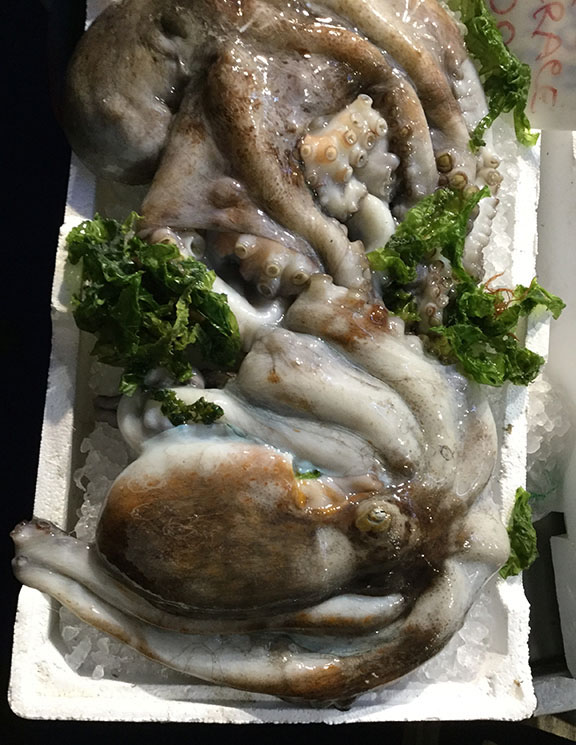Finally we can narrow down the date when our ancestor Domenic Troisi answered that help wanted ad for a job at Penn Garment Co. and moved to Williamsport, because he is listed in a Williamsport city directory dated January 1, 1914 — as “designer” boarding at 166 Mulberry. See it here:

]]>Article about Donatus Buongiorno published in academic journal



I had another opportunity to meet them a few days later, so I brought photos of Aunt Mary and accosted the unsuspecting woman. She is Giovanna Rega, and she denied being a Troisi in all directions of her family tree. Short of blaming it on the milkman, I had to give up my line of inquiry, but I did tell her she’s my “cugina” whether she likes it or not.
The video is exactly the “Chamber of Commerce” production you think it will be—old/new food, sights, history, etc—but it’s also good. It presents the city in a way that I find authentic to how I experienced it last year, and I don’t roll my eyes at it—which is always the ultimate test, right? I would love to hear if my traveling companions agree.
And by the way, the interview below the video, is a Q&A with the author asking questions and the mayor of Naples, Luigi de Magistris, replying, made during the mayor’s tour of NYC in 2015. Yes, the very same mayor whose office Julie and I toured last year! You can read about that adventure here: https://feetonthegroundnyc.com/2019/01/03/tour-of-city-hall/
I’m definitely going back to Naples and Solofra, maybe in 2020 or 2021. All family members are invited! Anyone who’s interested, let me know! It’s not too early to plan (and get excited)!
]]>Day 19: Tuesday, 6 November 2018.
Fiumicino, flight home.
Got up, had coffee, took cab to airport.
More coffee in airport, in a tiny restaurant among the hideous, all-shopping “gates” area.
Though the Italians get major, major kudos for naming their capital city airport after an artist-scientist-thinker (rather than a politician, yawn), they lose points for having figured out how to make an entire airport into a shopping mall.
You know how you usually check in, go through security, then pass through a hall of duty-free stores where you buy chocolates to get rid of your extra coins before peeling off to a corridor of gates with areas of seats with a few coffee bars around?
Not so Fiumicino any more. You never get “past” the stores. They are everywhere: next to the seats, next to the bathrooms, next to everything. There is noise and chaos everywhere.
Some would say “noise and chaos everywhere” describes Italy accurately, and, therefore this airport is…representative.
Oh my, I am getting cranky, and I’m not even on the plane yet. This trip is definitely over.
Day 18: Monday, 5 November 2018.
Travel from Caramanico Terme, Pescara, Abruzzo, to Fiumicino, Roma, Lazio.
Long day in car but very pleasant drive. We drove north out of Caramanico, which was faster and more efficient (to get to a highway) than the southern approach had been coming in. Again, the landscapes were stunning.
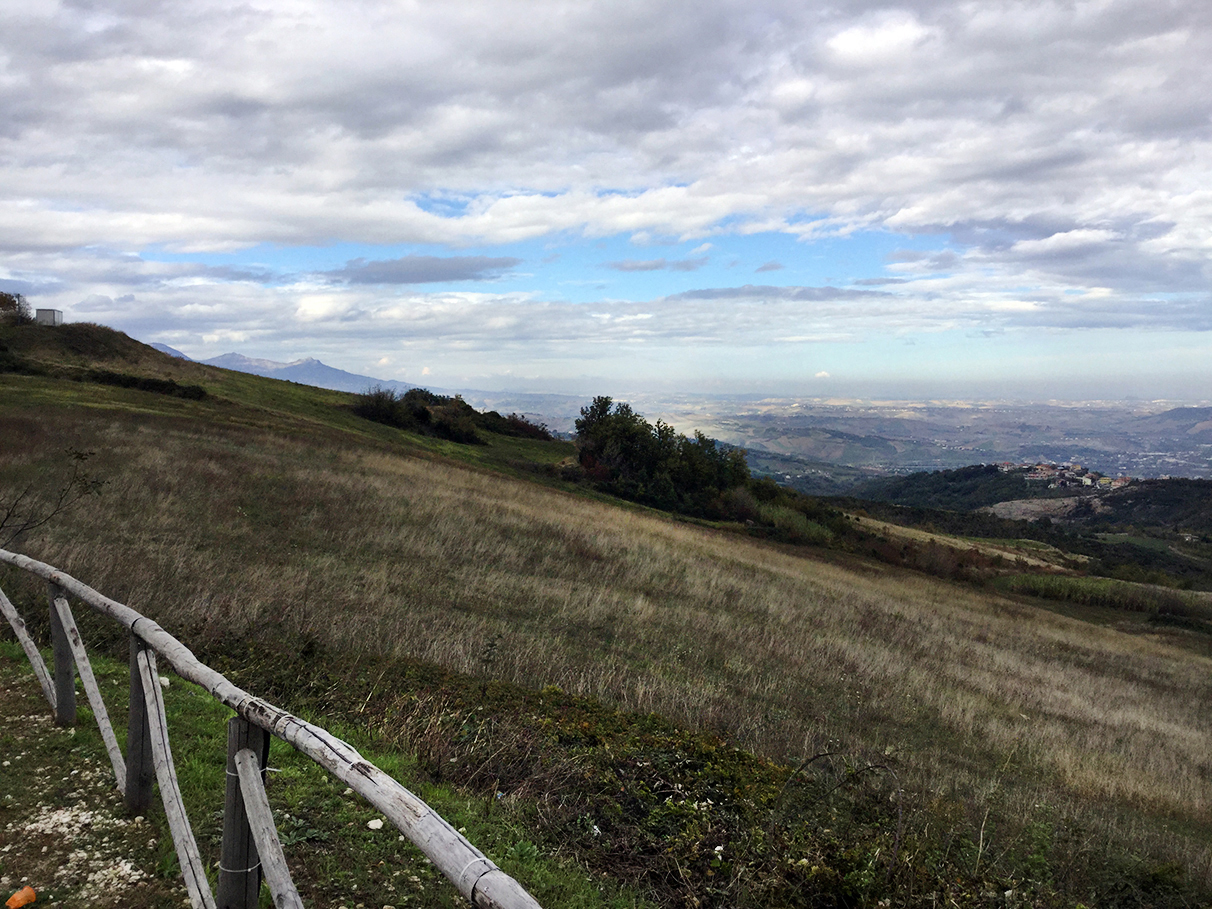

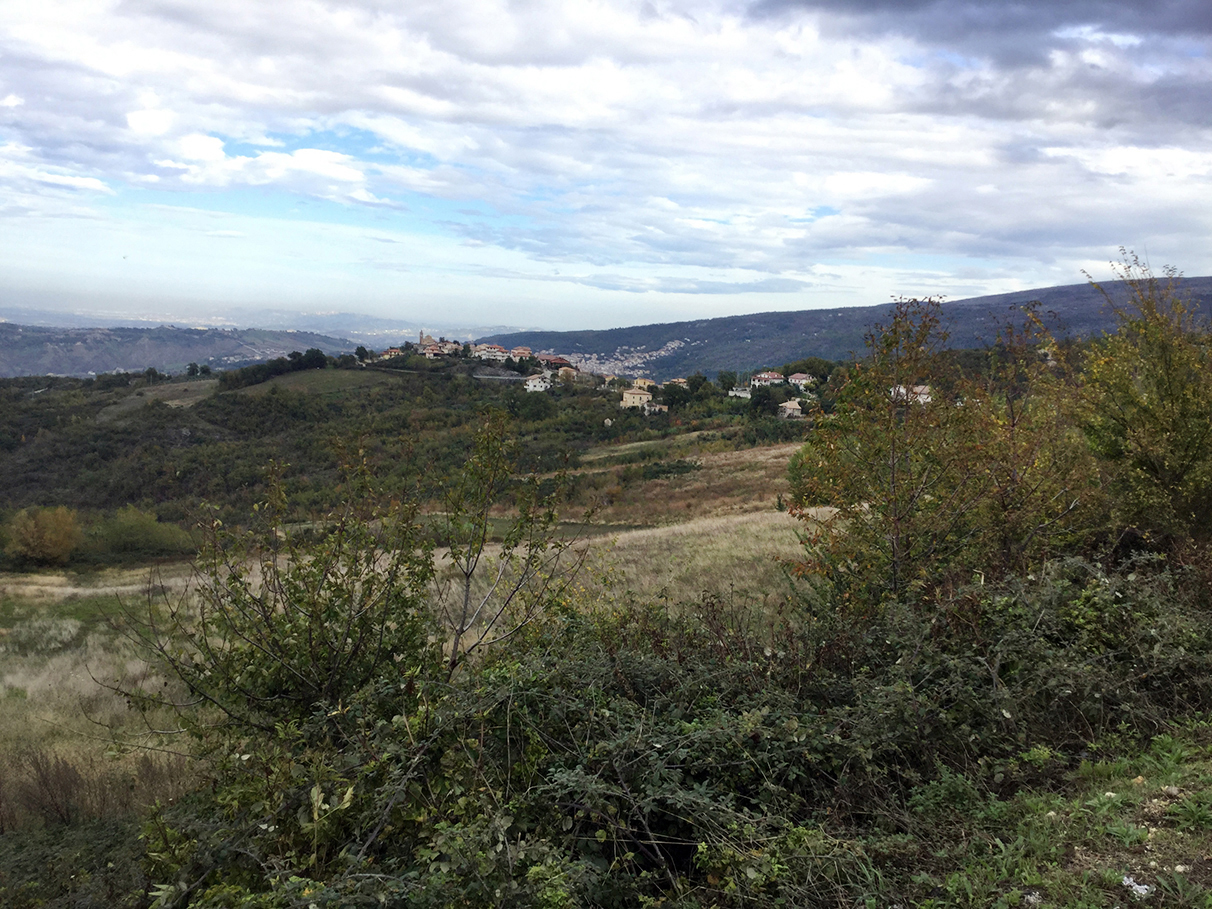
The highway itself, from Scafa to Rome was pleasant and not crowded. Many tunnels through mountains and bridges over gorges made the route rather efficient. The first stretch, in a valley between two ranges of mountains, had beautiful scenery and many pretty looking hill towns off to the left and right.
Around Rome, we hit a wicked rain storm and weekday rush hour, which made me think about the appeal to Matteo and Francesca (owners of the restaurant in Caramanico Terme) of living in a “slow” town that’s only two hours away.
We got to our B&B in Fiumicino which was lovely: a spacious 2-bedroom apartment/half-house, ground floor, with the owners upstairs. We highly recommend it for “airport night” stays, if anyone is interested. It costs you another 20 euros for the 15-minute cab ride to the airport (which owners will book for you), but you still net out below the nightly rates of nearby, “real” hotels.
Fiumicino is a pretty, seaside, holiday town with a main street of restaurants and shopping and a small marina with pleasure boats. We took a short walk along the waterfront one night to get our sole view of the Mediterranean of the whole trip (unless looking down from an airplane counts.)
]]>Day 17: Sunday, 4 November 2018, evening.
Caramanico Terme, Pescara, Abruzzo. Dinner in Caramanico Terme.
We had a fabulous dinner in a lovely restaurant that is owned by an out-of-towner: Taverna Ducale.
See more about the restaurant here, including my review (as donatus_buongiorno).

Taverna Ducale is owned by two Italians who moved to Caramanico Terme from elsewhere in Italy: Waiter Matteo, who explained all of the wonderful dishes in detail, and his wife Francesca, who does the cooking.
We had figured out by now that, unless you were born in Caramanico Terme, you are destined to be labeled an “outsider” your whole life.
Why did they move there? Slower lifestyle in a remote place.
So 100 years after our family left, a reverse migration, of sorts, is happening in some parts of Italy? Very interesting.
]]>Day 17: Sunday, 4 November 2018, afternoon.
Frazione Scagnano, Comune di Caramanico Terme, Pescara, Abruzzo. The search for house #31 on Via Something continues.
Sometimes serendipity pays off in the most amazing ways.
In the course of preparing for our trip, in September of 2018, I sent an email to a Carapellucci in the U.S. who is from a different family than mine (though his grandparents were from another Abruzzese town not far from Caramanico), with whom I compared genealogy notes 10 years ago. His name is Dan, and he’s a gregarious sort, so in the throes of frustration over Italians not replying to my emails, one night I thought, “I’ll write to Dan, because he’ll reply.” I sent him a cheeky “Heh, we’re going to Caramanico in a few weeks, need photos of anything?” figuring we’d have a nice chuckle.
It bounced back: dead email address, but I don’t give up easily, so I guessed at a few “generic” possibilities, e.g. [email protected] and other similars, and sent it again. A David Carapellucci in Canada forwarded it to his mother, Vilma Carapellucci, who replied. She is actually Vilma Ricci married to Gino Carapellucci, and guess what? Vilma and Gino are both Italian-born, from Caramanico, migrated to Canada in the 1970s, Vilma speaks Italian and works at the Italian Consulate of their Canadian city. I hit the jackpot!
Though we couldn’t figure out how we (the Carapellucci of Schenectady, New York) were related to her husband Gino, Vilma looked at our 100-year old birth and marriage documents and gave us some information on churches, locations, etc., and set us up with some people to help us in her hometown while we were there.
First day back in the U.S. from our trip, I heard from Vilma.
On Nov 6, 2018, at 5:16 PM, Vilma Carapellucci <xxx> wrote:
Hello Janice
How was your visit to Caramanico?
Haven’t heard and was wondering what you were able to discover.
Vilma
My reply:
Dear Vilma:
The trip was great. Caramanico Terme was lovelier than we ever anticipated. We expected a poor, rundown place that was trying to hang on with an invented “spa” industry.
Wrong.
It was like a Rocky Mountains ski town, my sister Loraine said. Meaning: there’s a main event (skiing in the Rockies, spa treatments in Caramanico Terme) plus, for affluent people who need something to do between their main events, there are ancillary services (restaurants, brew pubs, pastry shops) and upscale shopping (clothes, housewares, collectibles). And I thought Americans were the only people who eat and shop as recreation.
We found all the churches we sought, but we had a hard time searching out the home addresses that are on our various vital records: Via San Tommaso 31, Via Fonte Santa Croce 31 and Via Scagnano 31.
And wow, people were so friendly and helpful, even those who had no information to be helpful with—but wanted to talk at us in Italian for an hour or two anyway.
First, we had advice from Davide Cristofaro who owns the Hotel Arimannia where we stayed. (Beautiful place, by the way, recommended to all.) It was useful, but he dismissed the notions of visiting Scagnano and San Tommaso, because, you know, frazione, peasant villages with none of the appeal of the thriving metropolis of Caramanico (population 2,000).
Sorry bro’, that’s where our people are from; we’re going there.

We drove around the two frazione and tried to figure out which houses were old and how the numbering system works. It was obvious that the stone, unearthquake-proofed buildings are the old ones and that most, being unsafe to live in, have been abandoned or are used as garages by people who have built newer houses nearby on their own land. None of the old buildings still had numbers on them. Sometimes they were between, or slightly behind, the newer houses, so we tried to guess: Is that number 31, if the new house in front of it is 29?
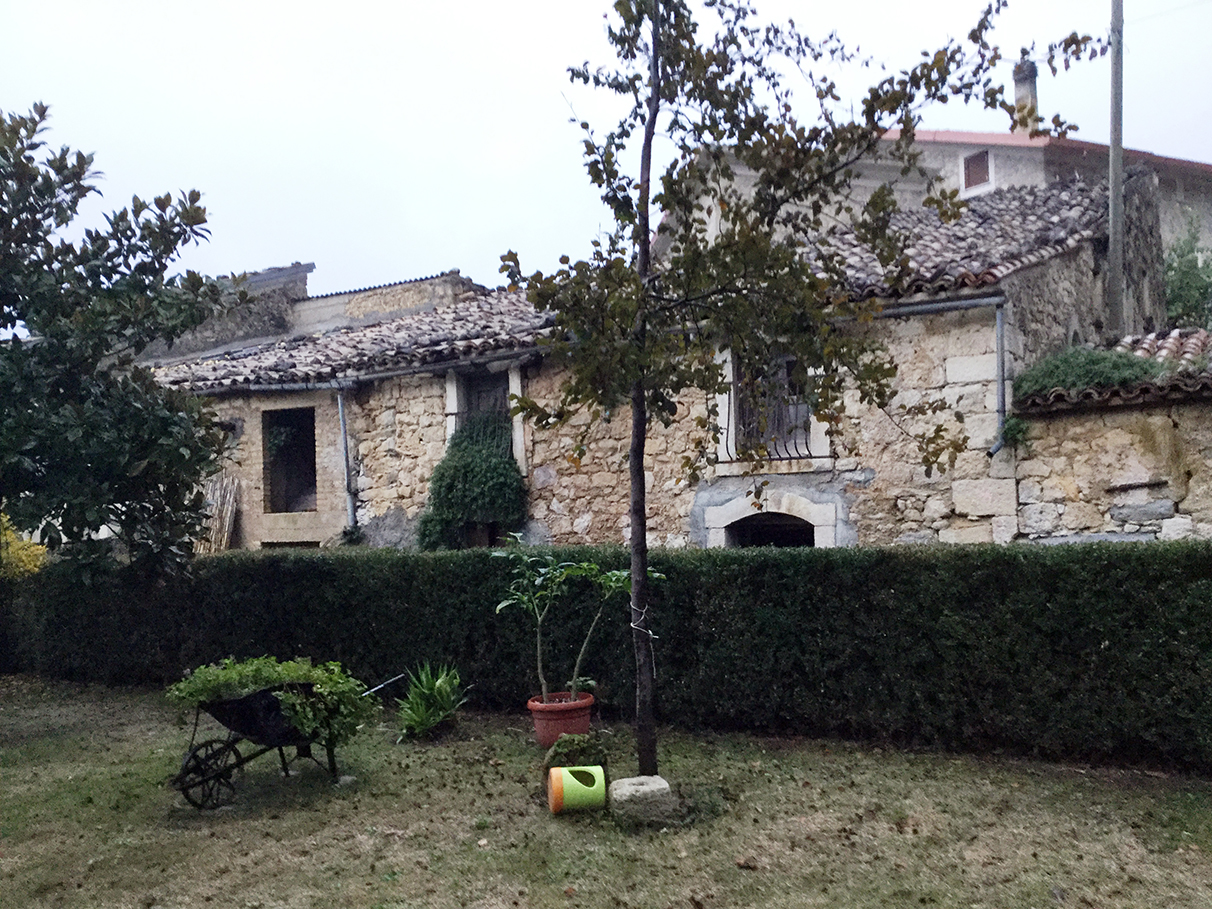
But the numbers aren’t consecutive on the streets, nor do they follow the American system of odd numbers on one side of the street, evens on the other side. The numbers don’t even go in the same direction on both sides of the street. Whew.
In Scagnano, there was a woman outside her house, so we introduced ourselves and she, Diana, knocked on the door of an elderly neighbor: “Do you know anything to help these people? They are Carapellucci and Marinucci (our great-grandmother’s maiden name).” Nothing. Then we visited another neighbor who told Diana, “Davide called me yesterday,” and she had nothing. (She was too young.)
Then Diana thought, “They need to talk to Angelina and Gino.” She got in her car and commanded we follow her to their houses, where Angelina invited us in for cookies. (Pizelle! Oh my God, we love those cookies!!!)
Angelina yells upstairs to wake her cousin Gino (who, we figured out later, lives in an adjoining house), who starts puzzling over our documents and talking/arguing with Angelina about this and that. They were both Marinucci, but Angelina’s maiden name is Carapellucci, so the plot had thickened.
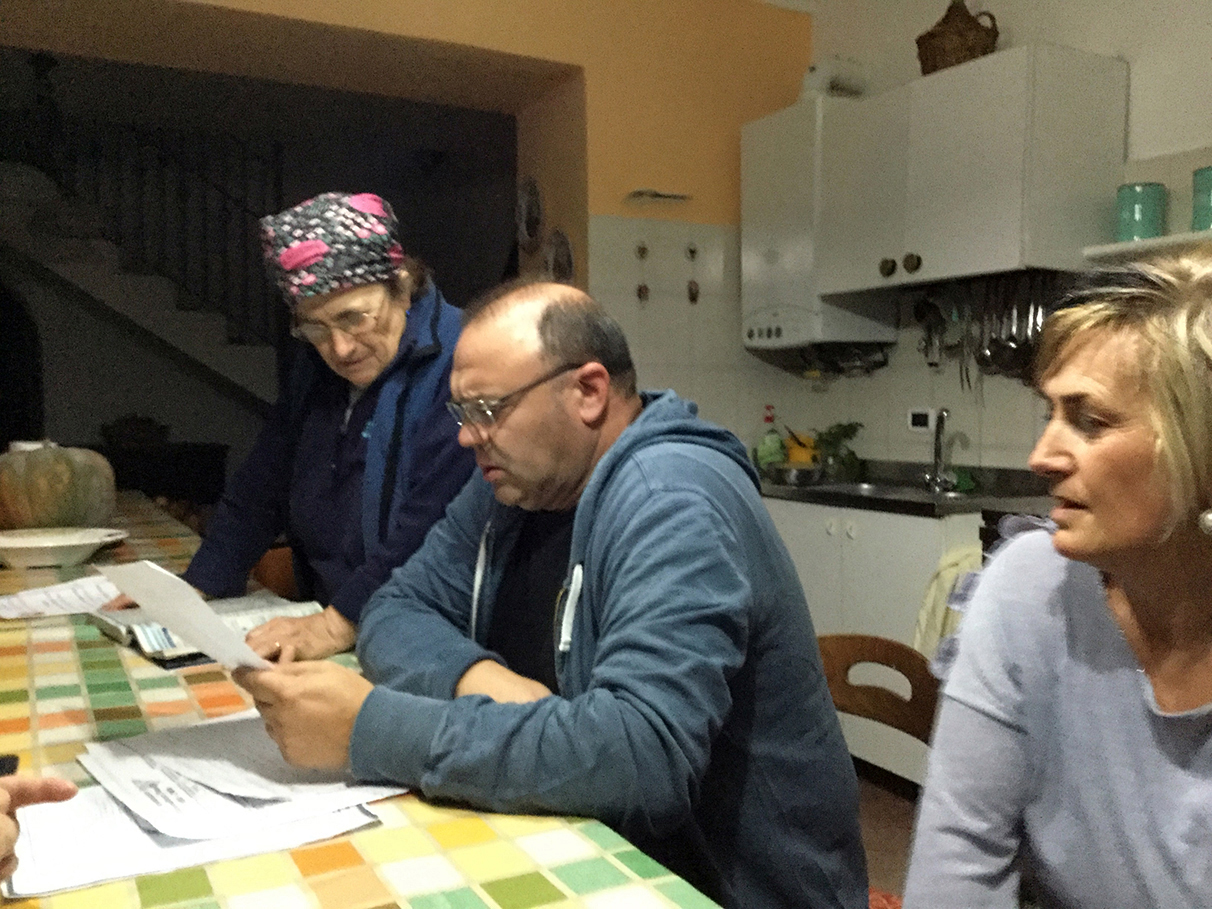
We piece together that our Carapellucci people started in Caramanico, but our great-grandfather, Antonio Carapellucci, moved to Scagnano, presumably when he married Anna Marinucci in 1877—maybe to acquire land from her family? (We think they must have had something to sell in Caramanico and/or Scagnano before they left in 1907, as they bought a farm in the U.S. only a few years later. Where did they get the money?)
After about a half hour of the two of them puzzling over the documents (Diana left in the meantime), my sister Loraine whispers to me “I think these are Vilma’s people.”
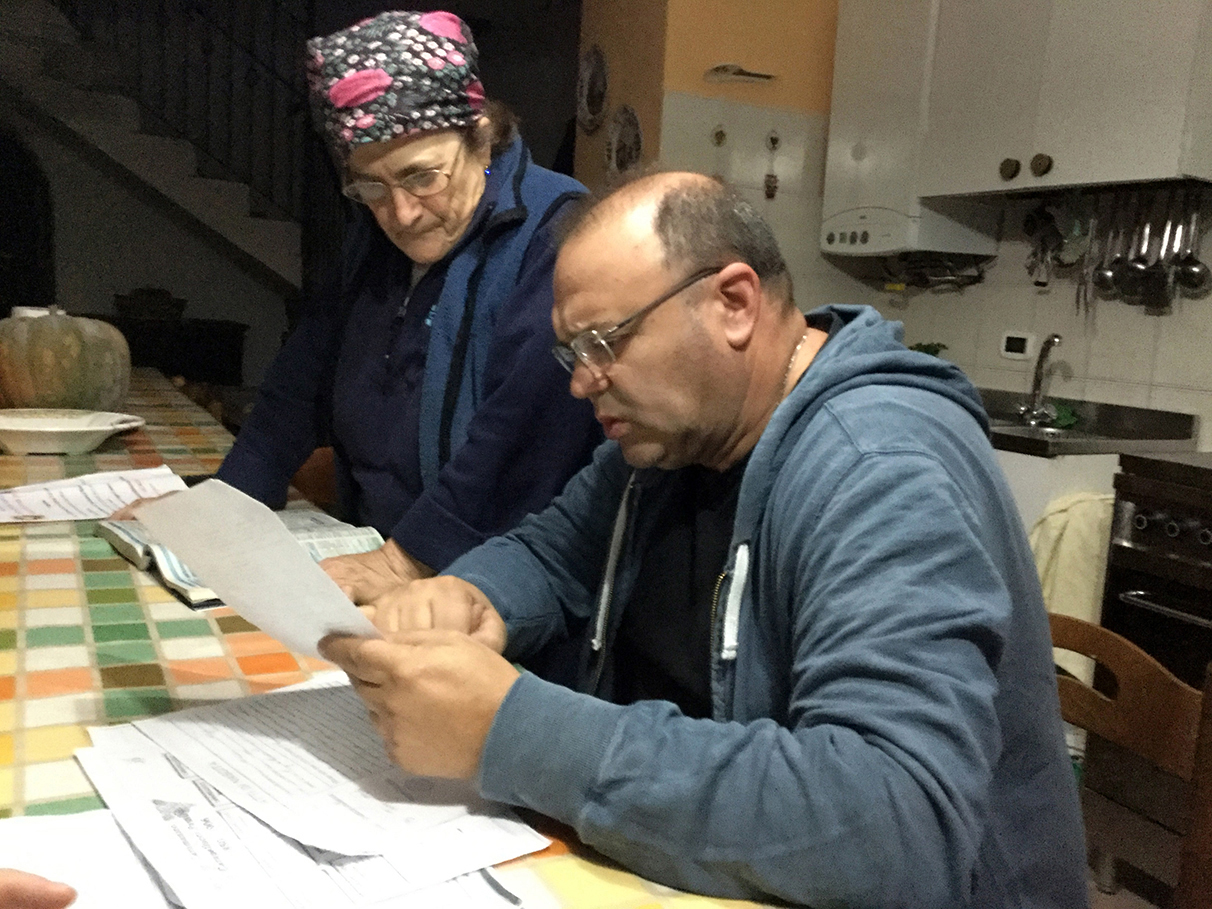
So now we’re looking at each other (3 of us: me, Loraine, Loraine’s husband) like “How the hell do we get out of this woman’s kitchen so we can go eat dinner?” (We were hungry.)
Then we asked Gino something about “Via Scagnano” and he comes out with “All the streets in a frazione have the same name—the name of the frazione.”
Huh? So all the streets, even if there are 4 or 5 of them, are named “Via Scagnano?”
“Yes.”
That’s it. We’re wasting our time. The address of the restaurant we found on Google Earth years ago, which we were counting on using as our reference point (Tana del Lupo; Contrada Scagnano 19), is irrelevant, and we’ll never know which house on which street was number 31 in 1907. Let’s go.
Then Gino says, “And they re-number the houses periodically.”
Us: “How often?”
Gino: “Every ten years or so.”
Oh my God this is really pointless!
But by then they had called Elvira Carapellucci, 80-something woman with dementia, and insisted we visit her to see what she knows.
Back into the cars, Angelina rides with us and directs us to Elvira’s house.
Elvira’s attendants ask her questions and she has nothing for us, so we make our exit graciously, drive Angelina back to her house, resist her entreaties to come back tomorrow for spaghetti (she had given us a demo of pasta making earlier when we were in her kitchen), and make our retreat.
I’m not complaining, Vilma. It was fun. Your relatives were all soooooo nice. They really, really wanted to be able to help.
And it was such a pleasure to listen to people who knew how to pronounce “Carapellucci” and “Marinucci” smoothly and without pausing, because we’ve lived our whole lives (in the U.S.) hearing stumbled syllables followed by “Is that an Eyetalian name?” (To which I now reply, by the way, “It is, but it has also been an American name since my grandfather naturalized in 1918, and it’s time for you to learn how to pronounce it.”)
And Gino did answer our questions, finally, even if it inadvertently!
We also thoroughly enjoyed the drives through the mountains approaching and leaving Caramanico (we entered on the roads from the south and left via the north), and we understood our American ancestors much better after seeing how much that part of Abruzzo looks like the Adirondack mountains in New York State where they settled: deciduous trees with autumn-colored leaves! I’ve never seen that elsewhere in Italy.
Even standing in Elvira’s driveway: out in the “country” away from the lights of the big city of Caramanico, we enjoyed looking at the stars in the totally black sky, which is something we never see on the east coast of the U.S. (because it is so populated).
The landscape of Abruzzo is unique and especially beautiful. I can understand why you, or anyone who is from there, would feel possessively proud of it. You have very good reasons. We’re thinking we might even return one day to hike in those glorious mountains.
Thanks for ALL your help, it was major.
Send me pics of your next trip. Now that we will recognize places, it would be really fun for us to look at someone else’s vacation photos from there!
Janice
Loraine adds: Janice left out the most important part. Angelina and Gino recognized the names of the Marinucci witnesses on our ancestors’ birth certificates. Angelina and Gino are related to us on the Marinucci side, we just don’t know how yet, and we will keep working to figure it out. Your family is wonderful, just wonderful.
-Loraine
Janice adds:
Ps to Dan: if you ever see this post, send me an email from your new address, dammit—I’ve got photos to show you!
——————————–
Epilogue: The next day, Loraine, who had clearly been cogitating on this all night, figured out that “our” #31 house is one of the old “garages” in front of Gino and Angelina’s houses. Our Marinucci—Anna—left so long ago (1907) that no one remembers her anymore, but Loraine thinks that because she was a contemporary of those witnesses, from whom Gino and Angelina are probably descended, probably all three families lived in those shacks at the end of the driveway next to the two new houses where Gino and Angelina live now (not in photo.) Anna Marinucci and her husband—“our” Carapellucci (Antonio)—sold their shack to one of the other two Marinucci families and left town. Luckily, I had snapped a photo of the “garages” when we pulled in, just before the sun went down. Here it is—the three low roofs, only. (The tall building on the far left is a real house, inhabited by someone we didn’t meet.)
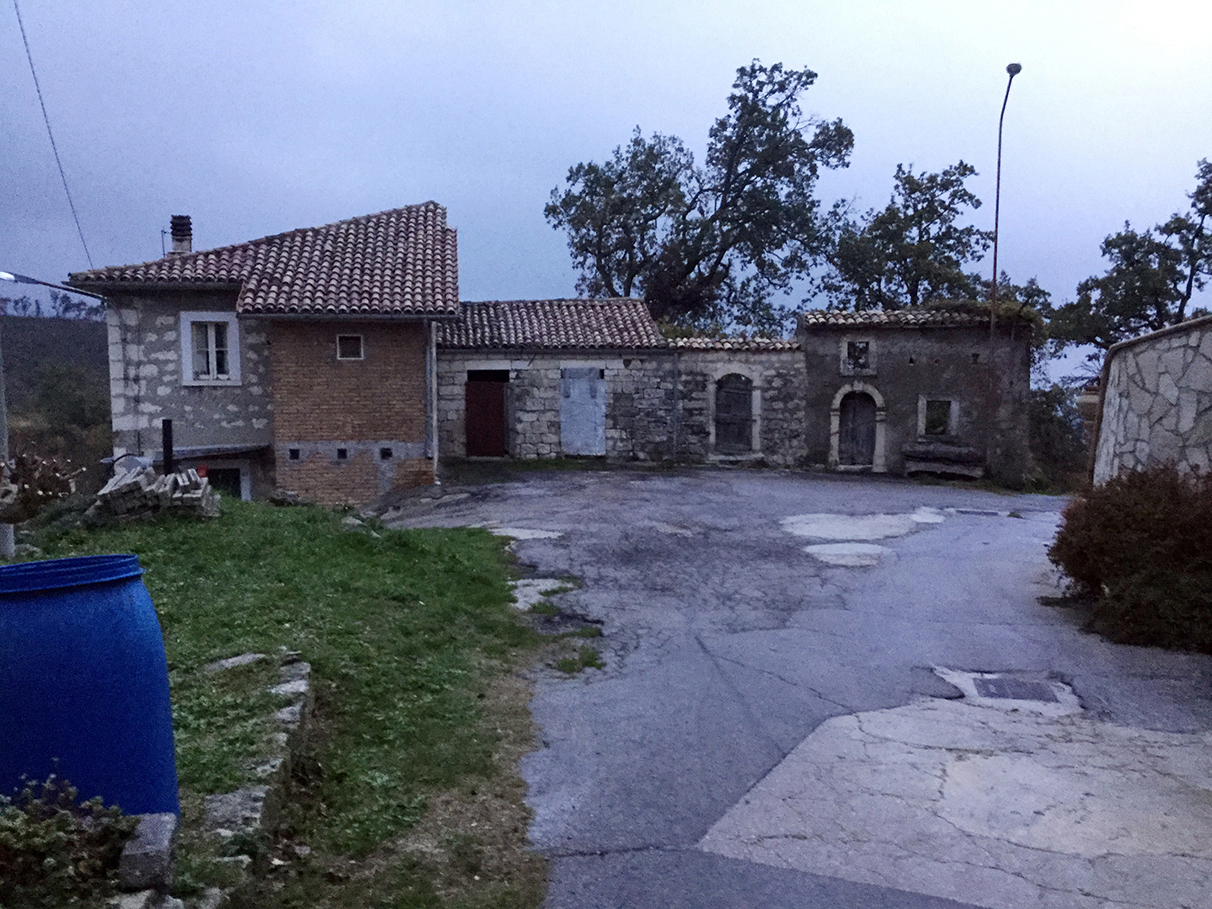
And there’s always Google Earth which has better lighting.

So that’s it, and we are owning it: Our grandfather, Emilio Carapellucci, was born in, and grew up in, one of these three shacks in Scagnano, Frazione of Comune of Caramanico (now Caramanico Terme). We found our roots, people!
Day 17: Sunday, 4 November 2018, morning.
Caramanico Terme, Pescara, Abruzzo. The search for house #31 on Via Something.
Wow, what a pleasant day. We left our hotel to discover a parade forming on the road below: Veteran’s Day. Brass band, veterans identified by Tyrolean-looking felt caps, and, yes, we were welcome to join the parade which was about to walk through town. Why not? (Brother-in-law Dave, who has not one drop of Italian blood in him, plays trombone, so when we see brass instruments, we throw him a bone.)


Most of the veterans looked too young for WWII, but we did hear a chilling WWII story about Caramanico locals harboring a downed British pilot in a barn and being lined up in the street and shot when the occupying Nazis discovered him.
My sister and I looked at each other and whispered: So if our ancestors hadn’t moved to the U.S., where they ended up fighting in (and surviving) both WWI and WWII in the U.S. Army, would they have gotten embroiled in this Nazi incident instead?
Here’s a movie of the parade in caramanico.
We followed the procession to one of the town’s churches, then peeled off and walked on our own.
We investigated the war memorial, the town hall, and the historic church with a roof that caved in during a big snow storm a few years back but, happily, is already being repaired. See photos.
Then we grabbed the car and headed for some outlying places on our list.
First was a pedestrian-only road at the far east end of Caramanico Terme called Via Santa Croce Fonte. We had found it on Google maps and thought it might be the location of our family’s ancestral home, house number 31.
It was quickly revealed why it’s pedestrian only: super steep, lots of stairs. We hiked up and down looking for number 31 and couldn’t find it. But there was a number 29, so we decided the one next door was 31 and snapped a lot of photos.
By this time, we had attracted the attention of the inhabitants of 29 who stood in their door chatting with us, then invited us in for drinks, etc. No thank you, no thank you. I was tempted by the two 8/10-year old girls who were so innocent in their curiosity that they stared at us non-stop the whole time we chatted with their parents. They had visitors who spoke English and broken Italian, and that alone was enough to make us fascinating, apparently.
We spent a few minutes in the small chapel next to 29, so that we would have “experienced it,” in case we discovered later it was our family’s church.
Then we left and drove north to the frazione of Scagnano.

]]>
Day 16: Saturday, 3 November 2018.
Travel from Solofra, Avellino, Campania, to Caramanico Terme, Pescara, Abruzzo.
We got up early (for Carapelluccis), said goodbye to our wonderful hosts, snapped a few photos of them and their lovely property, also the view of Solofra from their hill (finally with no rain and decent light), then hit the road for our longest driving day, from one grandfather’s hometown to the other’s: Solofra, in Avellino, to Caramanico Terme, in Abruzzo—about 200 miles.

We had a nice day riding through the countryside of Campania, Benevento, a tiny bit of Molise, and Abruzzo.
Major shout-out of thanks to my fabulous brother-in-law Dave who did all the driving and my fabulous sister Loraine, who navigated using Google Earth on her phone. I got to sit in the back and just look out the window all day, like a princess with no responsibilities. (Princess Marg, for family members who know what that means.)
I made one contribution: a one-hour stop in the ancient ruins of the Roman city of Saepinum (Sepino), just outside Altilia. Read about it here.
A city on a former main road which Samnites, and later Romans, used to move their animals north and south seasonally, this place is totally off the beaten tourist path, and you can have it all to yourself. Park in the nearby restaurant and walk around, free admission.
It’s probably not a place worth searching out, unless you have a serious obsession with ancient cities. Not me! I’ve been spared at least one obsession, thank you, but if you ever find yourself on the north side of the mountains near Naples, do check it out for the rare experience of wandering a Roman site at will and not having other tourists mess up your photos.

Click here to watch a contemporary performer on this ancient stage: Saep3
Being a graphic designer, I’m always a sucker for well-made Roman lettering. Pop quiz for anyone who’s been reading my posts from the beginning of the trip. What is the name of this font—it’s name now, having been known as “carved letters” at its inception, long before anyone knew anything about “fonts”?


Check out this “adaptive reuse” of a Roman plaque as the cornerstone of a medieval barn.

Back on the road, we see a lot of towns in the hills to both sides of the road. I expected back-county Italy to be poor and rundown. I’m pleased to report: not so. Though I only saw the towns from a moving car or at occasional rest stops on a highway, mind, I can report that there was farmed land everywhere (which was, presumably, thriving), every town had at least one or two factories (near the highway, plus maybe more elsewhere), and nowhere did the land or buildings look deserted, “untidy,” or rundown.
Plus, we saw multiple electric wind (mill) farms on the tops of ridges. At one point, we drove by a factory with parts out in the yard that I thought looked like airplane wings. Huh? Then it hit me: they were wind mill blades! So the mills were being made, and I guess assembled, mere miles from their sites!
I read later online that some people oppose the windmill installations for ruining their views of mountain ridges, but to us this is relative. In the U.S. we desecrate mountain tops with far more egregious strip-mining. I thought the windmills looked kind of cool.
Also, the roads were well maintained, including in areas with serious winter weather, and there were numerous tunnels through mountains and bridges over high chasms.
Our drives were a lot faster than our ancestors’ trips in horse-drawn wagons when they left these towns in 1907, that’s for sure.
]]>
Day 15: Friday, 2 November 2018, afternoon.
Solofra, Avellino: All Souls’ Day, Giorno dei Morti (Day of the Dead).
Back at the Agriturismo to dry off and prepare for dinner, we met some newly arrived guests: a couple and their young adult son from Argentina. The son’s English was very good, and he spoke with us.
He was an engineer, and he was treating his parents to this vacation to Italy. His father was a migrant to Argentina from Solofra, at age 8, in 1950. This was that man’s first trip back.
We looked at the father. He was obviously finding it very emotional. I was pleased for him. And a little envious. He was having the return visit my grandfather never had.
]]>Day 15: Friday, 2 November 2018, morning.
Solofra, Avellino: All Souls’ Day, Giorno dei Morti (Day of the Dead)
Unexpectedly, we got another shot at meeting with Lucia Petrone, and my sister Loraine Carapellucci and I jumped on it. Without the translator this time, Loraine wielded Google Translate on her phone and Lucia used Google Translate on her computer. Between the two machines and my tiny bit of Italian vocabulary, somehow we communicated with each other.
First, Lucia showed us two books on the town’s history. Were they available to buy? No. No more in print, no extras in the office to sell.
So Loraine and I started photographing their pages, then Lucia interrupted us to tell us more information and to show us stuff on her computer. She would start to talk, then stop and type frantically on Google Translate instead. I loved the woman’s enthusiasm!
Loraine and I whipsawed between looking at Lucia’s computer, looking out the window at the church across the street, and photographing those unavailable books.
Lucia told us the story of the construction of the Collegiata di San Michele church, which astonished us.
The night before, we had learned from Alfonso Buongiorno how the tanning industry Solofra families started as conversos (former Jews) from Spain who migrated to Florence in the 1300s, which was the tanning center of Italy. At some point, they were invited by someone (a land baron) to move to Solofra to set up a competing industry.
Lucia explained that there had been an old church on the site of the Collegiata which the families deemed inadequate. In the early 1600s (which would be approximately 200 years after the converso families arrived in Solofra, so presumably the tanning business was profitable by then), they demolished the old church and built the Neapolitan Baroque building that exists today.
If we got the translating correct, Lucia told us the tanning families of the town pooled their money to build the church, and the chapels inside are named for them. They also hired the priest, who, besides directing spiritual life, functioned as the mayor (of sorts, this is before suffrage) and settled civil disputes. At one point, there was an argument over some matter and the priest defended the town instead of the government/crown. He was arrested, and the townspeople got him released.
“Collegiata”—collegiate—in the church’s name means it was also a school. There was a convent attached, and the nuns taught classes. Most astonishingly, girls attended as well as boys. Today, the school is, appropriately enough, the town’s public library.
And the church had one more role in town: bank. The founders of the church would deposit their money, and the church paid them interest. When they needed it, they could borrow it back, and then they would pay interest to the church.
This is an astonishing amount of power and autonomy centered in a non-governmental, non-royal institution. I’ve never heard of it anywhere in Italy, let alone in the south where the feudal system endured into the late 1800s. Has anyone else? Did we get the translating wrong?
When I told the story above to my friend Bill Russo in New York, I expressed it as, “They hired the priest, and he worked for them, not for the Vatican.” Bill blurted out, “That’s how a synagogue is organized!”
Is Solofra’s extraordinary history of progressiveness, self-reliance and agency a cultural legacy of its original families’ Jewish roots? Did the historic, formerly Jewish culture of this town create my ancestors’ can-do, optimistic personalities?
Looking out the window, Loraine remarked, “But what about the campanile (bell tower)? It looks different from the church.”

Lucia paused and placed her hand over her heart looking very pleased. Her reply: The campanile was built with the stones from the old church.
Loraine pointed out to me later that that question seemed to change the tenor of the whole afternoon. A switch flipped in Lucia’s head (and heart) regarding us: they get it. They care, and they are becoming involved in our history.
A few minutes later, when we were photographing the books again, Lucia came to the table, closed both books and pushed them across the table to us. “A gift. Please take.” We were speechless.
I hope she decided that those books were going to do more good for Solofra being on our desks in the U.S. than in a cabinet in her office, because Loraine and I aim to prove her right! We traded emails and plans to collaborate on future projects.
At one point, Mimma De Maio phoned in, so I finally got to talk to her in person and thank her for all of her work which I have been reading for years. She was my first “door” into the history of this town.
I suspect I am going to be involved with my grandfather’s family’s Italian hometown of Solofra, Avellino, for the rest of my life. And I am well pleased.
]]>Day 14: Thursday, 1 November 2018, afternoon.
Solofra, Avellino: Visit to Casa Buongiorno.
As promised, Alfonso Buongiorno arrived at our Agriturismo (with his brother-in-law, whom he enlisted to drive a second car) on Wednesday afternoon to take us (party of 6) to his home on a hill above Solofra. Alfonso, his brother, and his father Francesco own one of the tanning businesses in town, and they have new homes near each other in a “compound” that they built on the side of a hill above the old part of town.
When I walked in and saw 19th-century paintings on the walls, I knew I had found a soul mate. Alfonso said, “They aren’t expensive. I buy what I like.” I smiled and made a mental note for a future project: get Alfonso interested in hunting for Donatus Buongiorno paintings that are in Italy.
We met his wife Maria Giaquinto, who is an Izzo from Montoro Superiore, a nearby town. Remember New Yorker Bill Russo whose parents were both from Montoro Superiore? Bill’s mother was Anna Izzo. I felt the spirits starting to circle.
Bill actually found Alfonso for me. On Facebook, of all things. Much as I hate that site, I’m grateful it worked for this, because meeting Alfonso Buongiorno was a highlight of my trip to Italy.
Next we met Alfonso and Maria’s two teenaged children, Raffaella and Francesco, who couldn’t hide that they were a little annoyed that company arrived just as they were planning to go out with friends, and they were now expected to linger and be nice. (The ritual for the holiday, apparently, is that adults go to the cemetery and youngsters go to parties.) I didn’t catch all of the words, but I think the gist of the whispered conversation was “Daaaaaad….,” followed by “Just stay for a few minutes and be polite.”
Next Alfonso guided us to his office in a corner of the living room and on the wall was this beautiful artwork of his family tree. Holy moly.
Then he pulled out a rolled up sheet with the family tree of “our” Buongiornos which I had emailed him before the trip (an org chart of boxes generated by a genealogy software program, with not-such-nice artwork). It was poster size. He ordered a digital printout somewhere.
(My work goes back to the 1850s and is based on vital records on microfilm I spent three years of Saturday afternoons reading at a Mormon Family History Center in Brooklyn. You’re welcome, Buongiornos and Troisis.)
Alfonso says, “I have figured out how we are connected. This Michele,” points to a leaf on his tree, “was a brother of this Biagio,” points to my chart, identifying two men who lived in the 1700s.
We are thrilled, and my cousins start snapping photos of all of us, of the “evidence,” etc. (Thank God they were there, because my brain was too overloaded to deal with a camera.)
Then Alfonso pulled out the “report” that an Italian genealogist prepared for him of records going back to the 1300s: a 3-inch thick, bound book, on archival-quality paper, with pages that fold out and flip around, xeroxes of some documents, raised-seal (legally legitimate) copies of others.

My cousin Lisa said later, “I kind of blanked out there for a few seconds, because I can’t even conceive that anyone’s ancestry could be known back to the 1300s.”
Alfonso turned to a page he had marked in advance and said, “We are Jews. Conversos from Spain.”
He pointed to a line he had underlined. “The family name Buondiaz (Bonadies in Ladino) was translated to ‘Buongiorno’ in Italy.” (Spanish, Ladino and Italian, they all mean “good day”—which is used for “hello.”)
My family members’ jaws dropped; I smiled with pleasure. I had heard of this possibility before.
Years ago, an Italian art dealer told me that Buongiorno might be a Jewish name, explaining that “conversos”—Jews who converted to Catholicism in Spain during the Inquisition—were also forced to change their Jewish-sounding family names. They often “hid in plain sight” by choosing very common words from the local language for their new last names, such as “hello, goodbye, good day, good year.”
Alfonso explained that the family were tanners in Spain. When they left Spain in the 1300s, they went to the tanning center of Italy: Florence. After being there for a few hundred years, a Solofrano land owner (baron) offered them a deal—land for tanneries, plus favorable terms (probably in exchange for substantial taxes)—to move to this place in the south that had the necessary raw materials (goats, sheep, water) to set up a competing tanning industry.
They have been successful. Florence and Solofra together produce 60% of the leather that is used by the Italian fashion industry today.
Now I understand why Mimma De Maio—the Solofra historian who wrote solofrastorica.it—did her Ph.D. dissertation on the “medieval” tanning industry of Solofra. Because that’s when the industry started in this town; her paper is about the entire history of this defining industry of this southern town.
And now I really have to learn Italian, so I can read that paper, and more of her website.
Alfonso’s family are still tanners. He and his father and brother own a tannery in town.
At some point, “my” Buongiornos, the ones descended from 1700-something Michele’s brother Biagio, left tanning, and by the 1800s, were tailors, barbers, midwives and artists (which I know from my Mormon Family History Center research.) Why and how, I don’t know. As always with genealogy, answers to questions beget other questions.
We are hours into our visit. Alfonso and I can go on about genealogy indefinitely, but our family members are ignoring us to eat snacks and talk about other subjects. Both teenagers are still in attendance, engaging with the American relatives they were sure would be bores.


————————
I would like to pay back Alfonso for his hosting and overall wonderfulness by finding him leads for selling his leathers, and this is where you, dear readers, can help.
The tanning industry in Solofra took a serious hit with the 2008 worldwide economic downturn, and Chinese competition is edging in. Alfonso needs a customer who can not afford the time and interruption lost to bad deliveries or not receiving enough usable product to fill an order—someone who will pay a higher price to get reliable product on time. We are looking for a very high end fashion/luxury wholesale customer: a manufacturer who makes gloves, clothing, shoes, wallets, belts, etc.
Do any of my readers know of such a customer? I would not be involved other than to pass a name and phone number to Alfonso’s sales rep in New York. Please use my email or phone to contact me, both are visible all over my websites, and THANK YOU.
————————
Thanks to my sister, Loraine Carapellucci, my brother-in-law, Dave Handley, and my cousins, Julie Holm and Lisa Hamm-Greenawalt, who shot the photos in this post.
]]>Day 14: Thursday, 1 November 2018, morning.
Solofra, Avellino: Ognisanti—All Saint’s Day
We started the day with a breakfast visitor: distant cousin Alfonso Buongiorno. He told us a little history of his family as tanners in the town and asked, “Would we like to visit his home later in the afternoon to see his family tree and talk more?”

“Hell yes, we’ll be there,” I was thinking, but I held back and pretended to wait for my family members to discuss it and come to a group decision. Arrangements were made and he left.
Then we trooped into town to attend the holiday mass in our family’s church. Feminists all, we were favorably impressed that the pastor, Father Mario, made it as progressive as he possibly could within the “rules” of a Catholic mass. Women parishioners helped served communion, and young girls did a reading.
After mass, we followed the crowd to the nearby cemetery, as visiting the dead is what you do on All Soul’s Day. It was down a hill about a mile away.
I walked with my sister Loraine for a while. She spied a broken-down chapel and asked if I wanted pictures of it. “Yes, thank you.” I didn’t tell her that it was one of the 5 or 10 “historic” buildings in town I had spied (and marked on a map) while “walking around” via Google Earth 10 years ago—checked that box. (By this point, I was keeping mum about some of my “planning lists,” as my family members were already worrying that I was a bit “around the bend” with my agenda for this trip.)

It was hard to imagine what Solofra looked like when our family lived there in the 1800s, because the 1980 Irpinia earthquake hit this town hard. Some buildings, like this chapel, were left as ruins, while others were rebuilt with new finishes (covered with a thick coat of cement-like material which ruins their historic appearance) or are completely new..
I’m a pokey walker and was lagging behind my family after 10 minutes or so, when…I got a ride! I spied an elderly man I had met the night before (in the church) in a car, waved like a maniac, knocked on the window, and he said, “Sure jump in and get a ride from my son-in-law” (the driver.) I pretended to chat and understand what the three of them were saying in Italian while cruising down the hill to where I met my family members who hadn’t even realized I was missing.
My sister Loraine got pulled out of the route by a local elderly woman who wanted to show Loraine her church, which was along the way. So Loraine went in and dutifully walked around for a few minutes.
Loraine and I found this happened routinely in both of our grandfathers’ small towns which we visited. People were interested in us and proud of their town and wanted to show us things. They also routinely didn’t care that we didn’t understand their non-stop Italian chatter.
The cemetery was interesting. There were lots of tombstones with photos on them and lots of mausoleums with family names on them, including names that we recognized, but we learned that none of them were going to be relevant to us: too new. We were told that graves (in most of Italy and much of Europe, apparently) are re-used after 50 or so years, that the bones that are dug up and put in common ossuaries without specific records of who is in them.
In all the years I’ve spent preparing for this trip, and in the flurry of emails during the last month before I left the U.S., someone couldn’t have told me this crucial detail?
Our ancestors left Solofra in the late 1800s and died in other places—Naples or the U.S. The graves of any family members before them who had been buried in Solofra had been recycled years ago, so we were not going to know anyone in this cemetery.
That kind of killed our interest, but I took a few photos of the more flamboyant tombs anyway, including this Egyptian style monument which can even be seen from the road outside the cemetery (Google Earth photo inserted because I can’t find my own shot), and this grave of a Russo that has a photo (of the dead guy), for my friend Bill Russo of New York, in case they are related, as his family is from Montoro Superiore, a town that is only a mile away from Solofra.

So the cemetery part of the “genealogy experience” of this trip was a bust. But it helped Loraine and I refine our plans for the second, small town we were going to visit. When we went to our other Italian grandfather’s home town the following week (in Abruzzo), we skipped its cemeteries.
We left the Solofra cemetery and went back up the hill for lunch in the main part of town. Then we went back to the Agriturismo to clean up (it had rained all day) for our visit to Alfonso Buongiorno’s house.
Thanks to my sister Loraine Carapellucci, and to cousins Julie Holm and Lisa Hamm-Greenawalt who shot many of the photos in this post.
]]>Day 13: Wednesday, 31 Ottobre 2018.
Travel from Napoli, Campania, to Solofra, Avellino.
Busy day.
We got up early, hustled to the train station, hustled to figure out how to buy the correct train tickets in a vending machine that was in Italian, figured out whose internationally registered credit card to use so it wouldn’t get rejected for being foreign (Julie’s), and hustled to get on the correct train. The one-hour ride to Salerno was pleasant and uneventful. It was a brand new train on brand new tracks.
We hiked through the Salerno station and crossed the street to a rental car place which was reasonably efficient (for Italians) at producing a car in under an hour. Then we wormed our way through local streets to get out of town and headed north on a highway. My sister Loraine was the navigator looking at Google maps or something on her phone and telling her husband Dave, the driver, directions, where to turn, how far to go until the next decision point, etc. It worked splendidly.
In Solofra, we went directly to the Collegiata church, figured out where to park, met our hired guide, Giuseppe Guanci, and got to the city hall by noon for our appointment with Lucia Petrone.
Big breath of relief.
Lucia is lovely and gracious—and speaks machine-gun-fire Italian. Giuseppe can hardly keep up, and when he’s translating to English for us, she interrupts him to tell him even more information in Italian. We hear about the city hall (former palace of Orsini family feudal land owners) and the Collegiata church (La Collegiata di San Michele Arcangelo), all of which I already knew.
It was the afternoon before a 4-day holiday weekend. Lucia had promised us two hours, and I think she was feeling the pressure, as much as we were, to pack those two hours with information.
Me: What about Donatus/Donato Buongiorno? He worked on a restoration of the Collegiata in 1908…?
Don’t know anything about that, but if you want to provide a (mural-size) copy of one of his paintings, we will frame it and hang it in our fancy meeting room here at city hall with the Guarini paintings (reproductions) we already have on display.
Not shabby company for Buongiorno, I think to myself, and make a mental note to follow up on this.
Lucia insists she must show us the church, so we go downstairs, cross the street, and go inside. In one of the big side chapels, Lucia tells us why the painting by Guarini is important: because the figure’s feet are dirty. Because that is proof that Giovan Tommaso Guarini, the Solofra-born artist of many of the paintings in the church (including the stunning scenes on the ceiling), did study with Caravaggio (in Naples)—because Caravaggio famously painted figures in religious paintings with dirty feet. (Caravaggio was an early modernist who re-introduced naturalistic details to reverent scenes.)
Then Lucia took us next door to the former convent and school, part of which is now the town’s public library. A few specific books had been pulled to show us. The librarians, or some other people, were hovering nearby, waiting for us to finish, no doubt, so they could leave early on the holiday evening. Lucia had those people make xeroxes for us. Julie shot photos, Giuseppe continued to try desperately to keep up with Lucia’s talking, and the members of our party surreptitiously took turns slipping out to use the library’s bathroom.
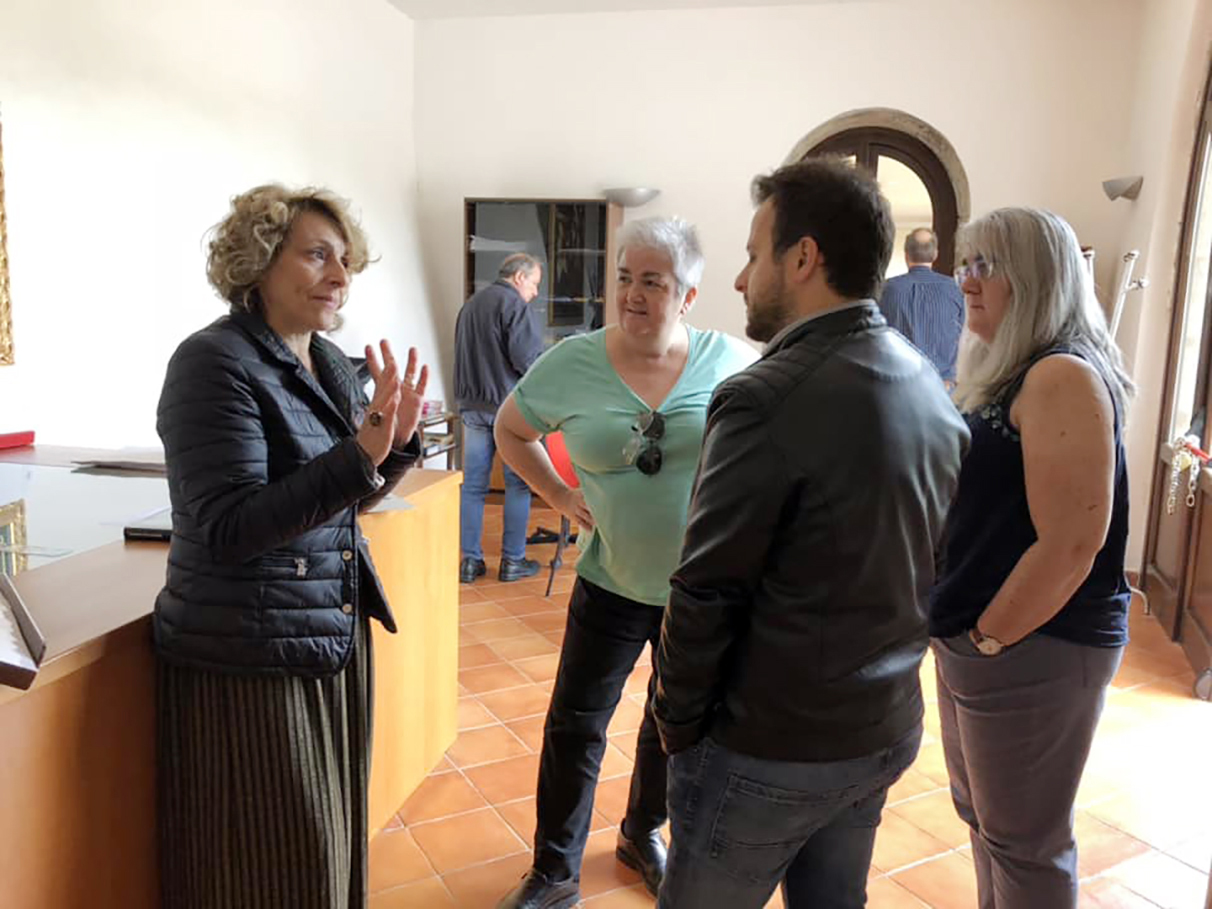
What a head full. I was exhausted trying to keep up with her, and frustrated that she didn’t know anything about the topics I am interested in: Donatus Buongiorno’s career, our family’s tenure in Solofra, etc.
She had to leave at 2 pm. We went back out front. We asked for a recommendation of a restaurant for lunch, and she pointed to La Taverna del Principe across the piazza.
We said goodbye and walked to the restaurant. I invited Giuseppe to join us. What a gold mine. Not only did it give him another two hours to translate for us, but he’s a gourmand who also narrated about the food—of which he approved. He told us that he’s no longer working as a genealogist, actually, but now runs gastronomy tours of the five provinces of Campania—Napoli, Caserta, Avellino, Benevento and Salerno. We let him order for us and choose all the wines.

If you are ready for a gastronomy tour of Italy that your friends who have been to Umbria and Tuscany can only dream about, give this man a call:
Giuseppe G.
Consulente di Viaggi | Aj54
Agenzia di Viaggi /Travel Agency | Aj54, very Authentic Journeys | Via Manfredi, 54 – 83042 Atripalda (Av) | Italy
Tel./Fax. +39 0825 460358 | M. +39 340 3137039
[email protected] | www.aj54.it
After lunch, he walked us to the best dessert place in town—Caffé Vignola—then said goodbye.
The night before, he had sent me some items he photographed at the Avellino library for me. Not until I was back in New York did I look at them and see that they are the 1911 articles about Buongiorno from Le Rane, a vintage local newspaper, which Mimma De Maio, town historian, cites on her site. Yeah!
We sat for coffee and pastries and tried to catch our breath.
Then we went back to the church to explore at a more leisurely pace. We chatted with “Don Mario” (Monsignor Mario Pierro), the pastor, and met some old men who seem to spend their days hanging around the church. (Curiously, the hang-arounders in New York City Italian Catholic churches are usually elderly women.)
We explained who we were, and, like Lucia, they shrugged at my story of Donatus Buongiorno restoring paintings in the church in 1908, but as soon as they heard “Canonico Troisi,” the flood gates opened. Canon Carmine Troisi, 1866-1948, pastor of the collegiate church for 50 years, was my great-grandfather’s brother. There’s a plaque with the priest’s name on the front of the church, and everyone in town knows who he was.

A few of the men took us into the sacristy to see its paintings (and a glass ossuary holding someone else’s bones including a skull, which was totally gross), and another room where Carmine Troisi’s bones are buried in an ossuary under the floor which has a carved, marble, plaque-like cover. He’s buried with other priests, too, we think—the translating was getting a bit shaky by this point. Then they showed us the farthest-back room, which looked like a school room, which they explained is where Troisi actually died. He had a heart attack or something during catechism class, apparently.
Whew.
So we visited great-grandpa’s brother the priest thoroughly. The priest for whom our great-grandmother, Maria Michela Buongiorno, Donatus Buongiorno’s sister, worked as a housekeeper before marriage, which is how she met great-grandfather Beniamino Troisi. They were married in this church in 1877. Have I adequately explained why we needed to visit this town?
Done with downtown Solofra for the day, we drove up the hill on the north side of town to the Terranova Agriturismo Solofra to check in. Cousins Lisa and Lexie were already there, having come directly from Naples separately from us. Our hosts, Maria Buonanno and her father Norberto Buonanno, are lovely. Later in the evening, Maria cooked us dinner and shot this group photo. (Signor Buonanno is at the table in the back on the left.)
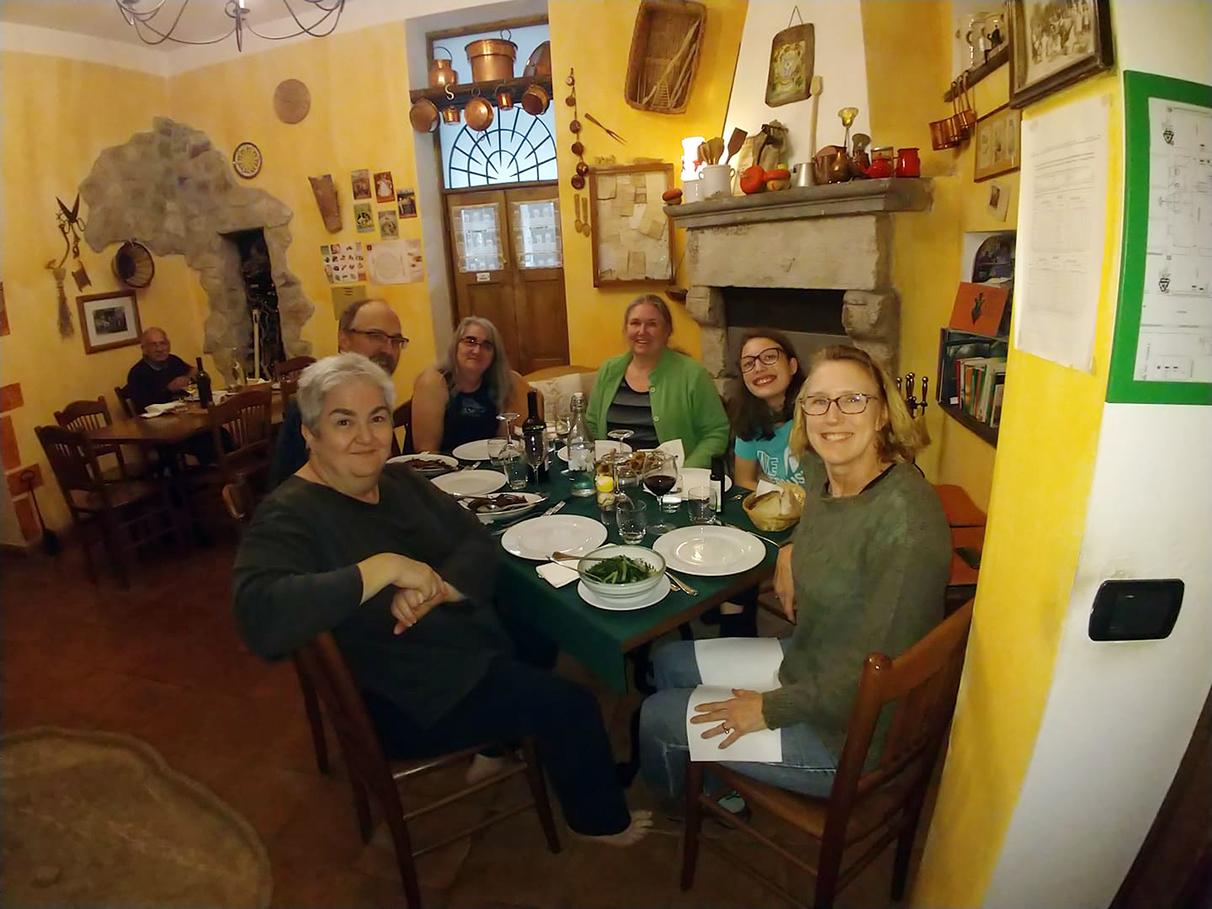
Day 12: Tuesday, 30 Ottobre 2018.
Napoli, Campania: Accademia di Belle Arti di Napoli.
My efforts to find out more about ancestor painter Donatus Buongiorno in Naples were thwarted at many turns, including his alma mater, the Accademia di Belle Arti di Napoli (Academy of Fine Arts of Naples.)
After a few false starts, and iffy leads to uninterested people, I finally hit pay dirt when my New York paintings conservator Luca Bonetti asked a conservator friend in Rome (Antonio Iaccarino Idelson, who doesn’t know me but thank you, Antonio!), who provided the name of Luciana Festa, who teaches stone (sculpture) conservation at the school.
See her talking about a recent project restoring Syrian sculptures here.
Luciana was the BEST. She talked to the school’s archivist and others before I arrived (a rarity among Italians, I’ve learned, who generally didn’t do anything until I was standing in front of them), and she sent answers to many of my questions in advance, which helped me plan the best use of my time on the ground.
We met for lunch and she provided the depressing explanation of why the school has no records of Donatus Buongiorno’s tenure in the 1800s: big fire after WWII bombardment by Allied forces burned up their archives. Mea culpa, mi dispiace. Not for the first time in Naples, I found myself apologizing for the actions of my army in the 1940s.
So I will provide the records “back to them!” I plan to submit a report of my ancestor’s career for their re-constructed archives.
Here’s the obligatory, blurry selfie of the two of us.
Day 11: Monday, 29 Ottobre 2018, a.m.
Napoli, Campania: Stazione Garibaldi, Metropolitana Linea 1.
Headed back to the apartment, I arrived at Stazione Garibaldi to the most taxing experience of my trip.
The ascensore (elevators) and scale mobile (escalators) were out of service, and men in uniforms with reflective safety vests were pointing people to the stairs. I couldn’t understand the guy’s explanation and figured I was being subject to an infamous Italian sciopero (labor strike).
The damned station is at least 150 feet underground and features four sets of elevators and four sets of stairs criss-crossing each other in a single, giant well that is open from the ground level to the tracks. I don’t like heights. The first time I exited Garibaldi station, I experienced nasty vertigo on the very long escalators out—which is why I had switched to using elevators (where you can’t see how high you are.)
This is the best photo I could find that is copyright-free (Thank you, Alpha 350.) Google other photos to get a stronger impression of how steep and dizzying these escalators and stairs are (45-degree angle.)
I said to myself, “Janice, pretend you have to do this to save your life, and just do it. Don’t look up, don’t look out, just look down at the stair treads until there are none left.” Resigned, I inhaled deeply and started up. It took about 10 minutes and wasn’t that bad, though I did have jelly legs for the rest of the evening.
I found out later the station was hit by a power outage.
During the 30 minutes that I was on the train, the whole city had been hit by a violent, windy thunderstorm—power lines down, roofs blown off, etc.
It was even reported in the New York Times, several friends from New York told me, with the mayor of Naples, Luigi de Magistris, calling it “an atmospheric earthquake,” whatever that is.
The lights in the station (of which there were plenty, no fewer than usual) must have been running on emergency generators. When I realized that, I wondered if the train had been running on generators, too, and quickly changed my attitude to “sure glad the damned thing made it into the station.”
I’ve worked for railroads, and I’ve taken their safety classes. I can tell you—enthusiastically—that I would be satisfied to never in my life experience walking in a train tunnel, in the dark, between tracks, with train personnel instructing me how to avoid hitting the third rail—thank you!
As the seven members of our party each arrived back at the apartment throughout the afternoon, we traded stories of waiting out the storm in museums, seeing loose pieces of roofs on the sidewalk in our neighborhood, and, for the family members who had returned to the apartment before it all started, closing the outside metal shutters and grilles on the windows, because the wind sounded strong enough to blow out the glass.
Later that night, we went out for pizza, and everything was more or less back to normal, surprisingly. Napoli has survived volcanoes. Not much else affects Neapolitani, apparently.
]]>Day 11: Monday, 29 Ottobre 2018, a.m.
Napoli, Campania: La Porta Capuana district, Via Cesare Rosaroll.
Back to Via Cesare Rosaroll and the slummy Troisi apartment with the whole gang. (See previous post for details.)
Lots of stunned silence—for the apartment and for the crappiness of the neighborhood in general.
We walked up Vico Cappella a Pontenuovo, a narrow street parallel to Via Cesare Rosaroll and Via Carbonara, to get a feel for an old neighborhood of Naples.
I’ve lived in un-modernized, cruddy tenement buildings in New York City, so this neighborhood didn’t faze me that much. Actually, I think it’s less bad than many inner-city neighborhoods I have seen (in the U.S. and all over Europe.) Some family members who are used to better housing were nonplussed.
What I did find wearying—claustrophobic, actually—after a week in Naples, and not just in this neighborhood, was the canyon-like narrowness of any street that was more than 200 years old and the overall darkness of buildings, sidewalks and streets, since the “local stone” is black, volcanic ash. Like this:
My favorite detail on Vico Cappella a Pontenuovo was the Spiderman motor cycle repair shop built into yet another tower of the former medieval wall of the city. See photo.
We saw these towers all over the neighborhood. Sometimes they were incorporated into later, substantial buildings, such as the well-known Garibaldi Barracks on Via Foria, and sometimes they had been turned into homes (!), such as the one shown below.

After the off-putting tour of the morning, we had a nice lunch to let everyone decompress, then we split to go several ways in smaller groups.
I headed south and west back into the old quarter to see Capella (chapel) Sansevero.
Giuseppe Sanmartino’s Veiled Christ is a stunning sculpture worth the money and effort, but the whole “attraction” is more cloyingly “touristy” than any other sights I had seen in Napoli, including the largest museums. I felt a tiny bit hustled, so I went into a “real” church afterward to relax for a few minutes.
Then I walked down the hill, explored a few new streets, and found myself on the musical instruments street that I had seen a week before with my Dutch friends. The “old” neighborhood is small enough that you can’t avoid repeating streets, I learned.
I headed to Piazza Dante and grabbed the metro to Garibaldi.
]]>Day 10: Sunday, 28 Ottobre 2018.
Napoli, Campania.
Sunday afternoon: family members arrive—two from Rome and three from Spain, joining one from Rome and one from Germany! The whole gang is now in Naples. We catch up on each others’ travels and make plans for dinner.
We can’t find the restaurant we chose from a guide book and “settle” for Avellinese food. It was fabulous.
A few nights later, when in Solofra, which is in Avellino, we ate at a “Neapolitan” restaurant. We couldn’t tell the difference, honestly.
Except that this category of not-pricey restaurants seems to always be overly lit, though I’m happy if they don’t have a t.v. blaring. (There’s often a calcio/soccer game on the t.v., but usually with the sound off which helps in ignoring it.)
]]>
Day 10: Sunday, 28 Ottobre 2018, a.m.
Napoli, Campania: Capodimonte Museum.
Julie and I got up early Sunday morning and booked it to the Capodimonte Museum, as the 19th-century apartments of the former palace residents are only open two hours a week, and I was determined to see every 19th-century painting in this city that Donatus Buongiorno would have seen while he lived here—in case I could identify copies, inspirations, etc.
There were no “finds” regarding his painting career, but there was a major find regarding a police action Buongiorno initiated in New York City in 1907. He reported a studio theft to the police—that a “Van Orley” painting had been stolen, a portrait of Protestant reformer John Calvin, which Buongiorno and an Italian art dealer had imported from Italy to sell in the U.S.
Buongiorno wasn’t treated very respectfully, as the casual racism and yellow journalism of reports in the New York Times and New York Sun reveal (“artistic hair,” “very broken English”.)
Bernard van Orley (c. 1487–1541) was a leading artist in Dutch and Flemish Renaissance painting and a designer of Brussels tapestries and stained glass.
He (and/or his workshop) made many portraits of European royalty, including seven of Charles V, Holy Roman Emperor, after he became King of Spain, and… on this Sunday morning, I discovered that the Capodimonte Museum has one of them! (The museum also has a substantial tapestry series based on van Orley drawings and, presumably, Buongiorno would have seen those, too.)
This confirms how Buongiorno would have known about van Orley, but I still suspect he “got taken” on the imported painting, as I find no record of a Calvin portrait by van Orley, though the two mens’ lives overlapped and van Orley was, against the tide, a Protestant.
So the plot thickens, and I have one more fact to add to the stew.
Many thanks to my cousin Julie Holm who shot a better photo of this painting than I did and is letting me post hers.
]]>
Day ?: Ottobre 2018, p.m.
Napoli, Campania: Corso Garibaldi.
I can’t remember which day this was, but the selfie is cute, and I wanted to put it in.
One night, Julie and I inadvertently crashed the family-only opening party of a new restaurant on Corso Garibaldi, a few steps from our apartment, right across the street from the Porta Nolana terminal station of the Circumvesuviana railroad.
We were hungry, and it looked good. There were quite a few people outside on the sidewalk and I said, “Oh it’s just the Italian smokers, we’ll cut through them.”
So we walked in. When we tried to navigate getting a table and menus, the (young) owner said: Don’t have any. We’re not open yet. But sit down and eat!
Then he proceeded to bring us drinks and taster-size food offerings, while children roamed around freely and nearby women made sure we had forks, etc.
They were so nice! And he wouldn’t let us pay him anything! He even insisted we take one dish with us, so we wouldn’t miss trying it.
Go there, people! The food was great!
Gusto & Passione
Corso Giuseppe Garibaldi, 42-43, 80142 Napoli NA, Italy
Phone: +39 081 1820 5856
]]>Day 8: Friday, 26 Ottobre 2018, morning.
Napoli, Campania: Il Sindaco al Palazzo Municipio.
I heard the mayor (sindaco) of Naples, Luigi de Magistris, speak in New York in 2015, when he made a round of visits to Italian American institutions to promote tourism to Naples. He was forthcoming, interesting, and charming.
A former prosecutor, he has a very interesting resume (Google him), and he’s a reformer with big plans for improving Naples. Indeed, only three years later, I experienced results of his work: garbage piles in the streets are gone, all of the subway stations are finished and open, and petty/preying street crime is down—thanks to military-style police with assault rifles who patrol in pairs in tourist areas (see blue circle in photo.)
Since I heard de Magistris speak, I’ve had it in mind to bait his office when I visited Naples, because why not?
So I wrote to the man in New York who organized the talk I attended with my pitch: My family is visiting Naples as a result of de Magistris’s visit to New York. (Never mind that I’ve been researching my Neapolitan genealogy for 10 years, I was prepared to give de Magistris full credit for the trip.) After leaving in 1907, we are the first to return, and wouldn’t he like to have a film crew follow us around to make a tourist promotion? We will be very entertaining, and we will only say good things about the city. Plus I have this fascinating project about a family member who was an artist who left in 1892.…
The man wrote me back a very polite note saying not sure about your proposal, but here’s the name of de Magistris’s assistant with whom I made the New York arrangements.
Pay dirt!
I wrote to the assistant: “My family is visiting Naples, and….”
She wrote back “We don’t have a film crew, but would you like a tour of city hall?”
Hell yes!
So Julie and I went to the Palazzo Municipio on Friday morning to check out the tour and see if it was worth doing again with family members the following week. We decided “no” for the family (not germane, limited time), but we had a blast.
Here’s the outside of the building.

We walked up to that gaggle of police officers around the green door, and I announced, “We have an appointment with Il Sindaco.”
Not this door. Go around to the side.
So we go to the side and talk to the municipal officers who are smoking cigarettes. “We have an appointment with Il Sindaco.”
They make some phone calls and yell to other people who are further inside and go back to smoking.
We wait. We wait. We look at each other: not sure we are going to get in here.
Then these two youngsters appear: Alessia Andreottola and Dario Riccio. They are our guides.
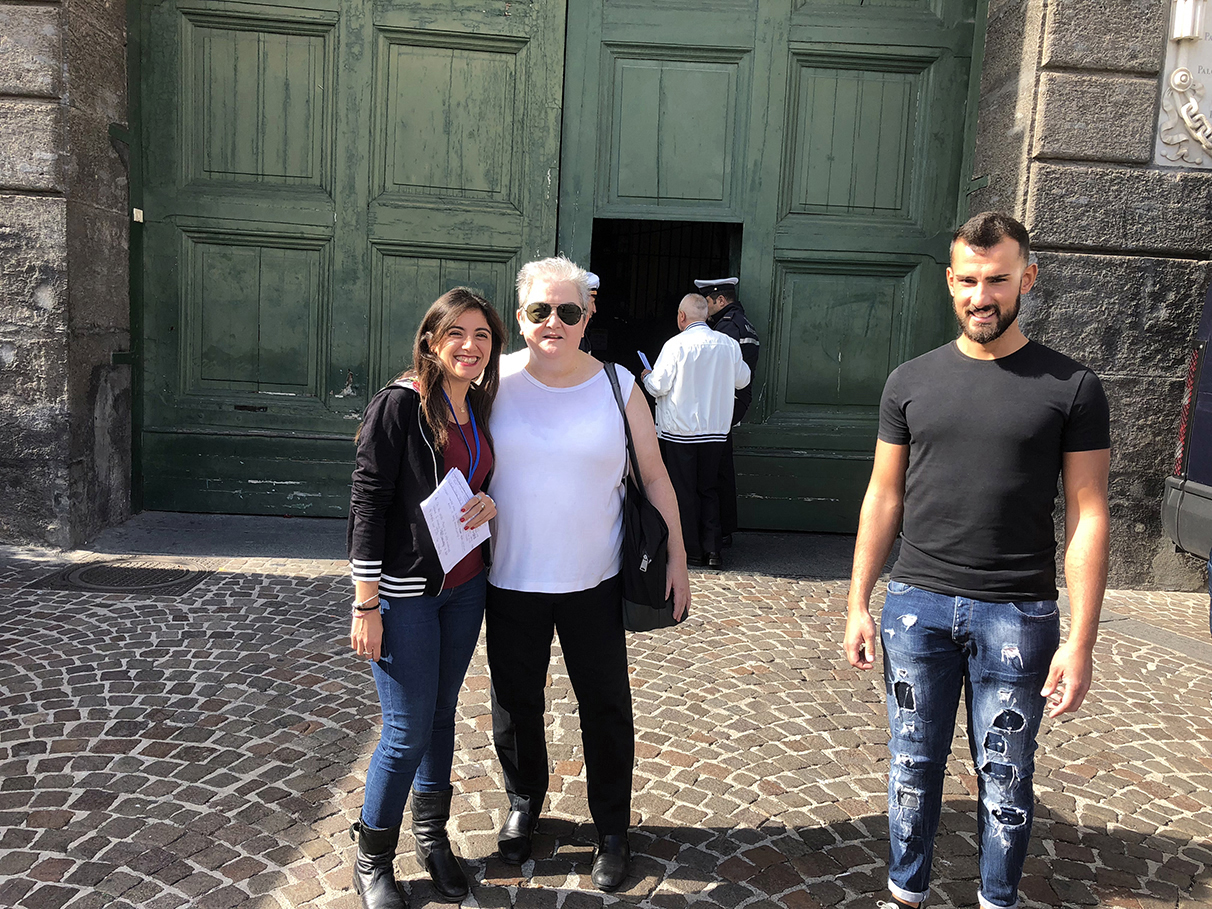
We walk in. No bag check. No pat down for weapons. No passports, no IDs. No security whatsoever. Interesting.
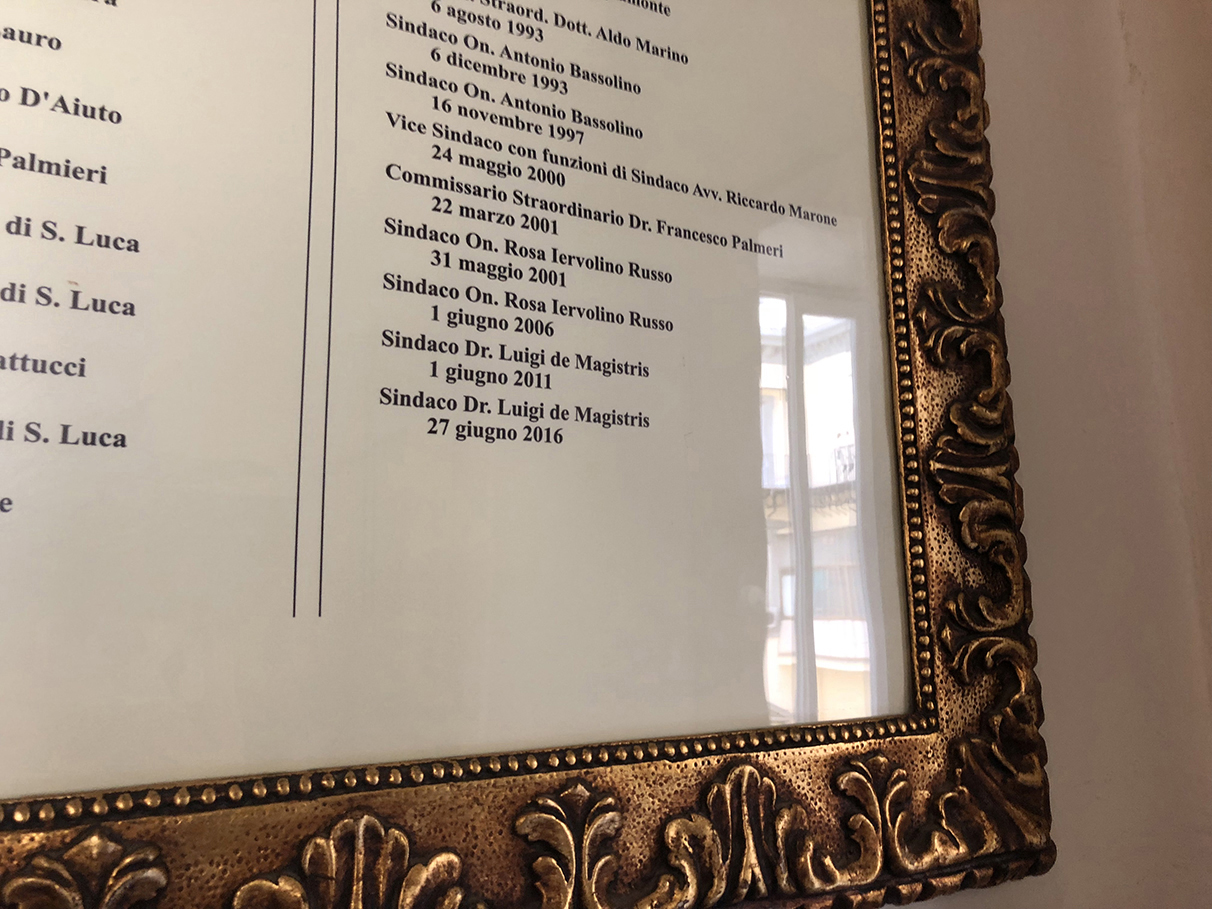
The palazzo is one of the many royal houses, or offices, or something, that were left over when Naples became a not-royal city upon the unification of the country. It’s a fancy building, with fancy rooms, and fancy decorations all over the walls and ceilings. Paintings, sculptures, and decorative objects everywhere.
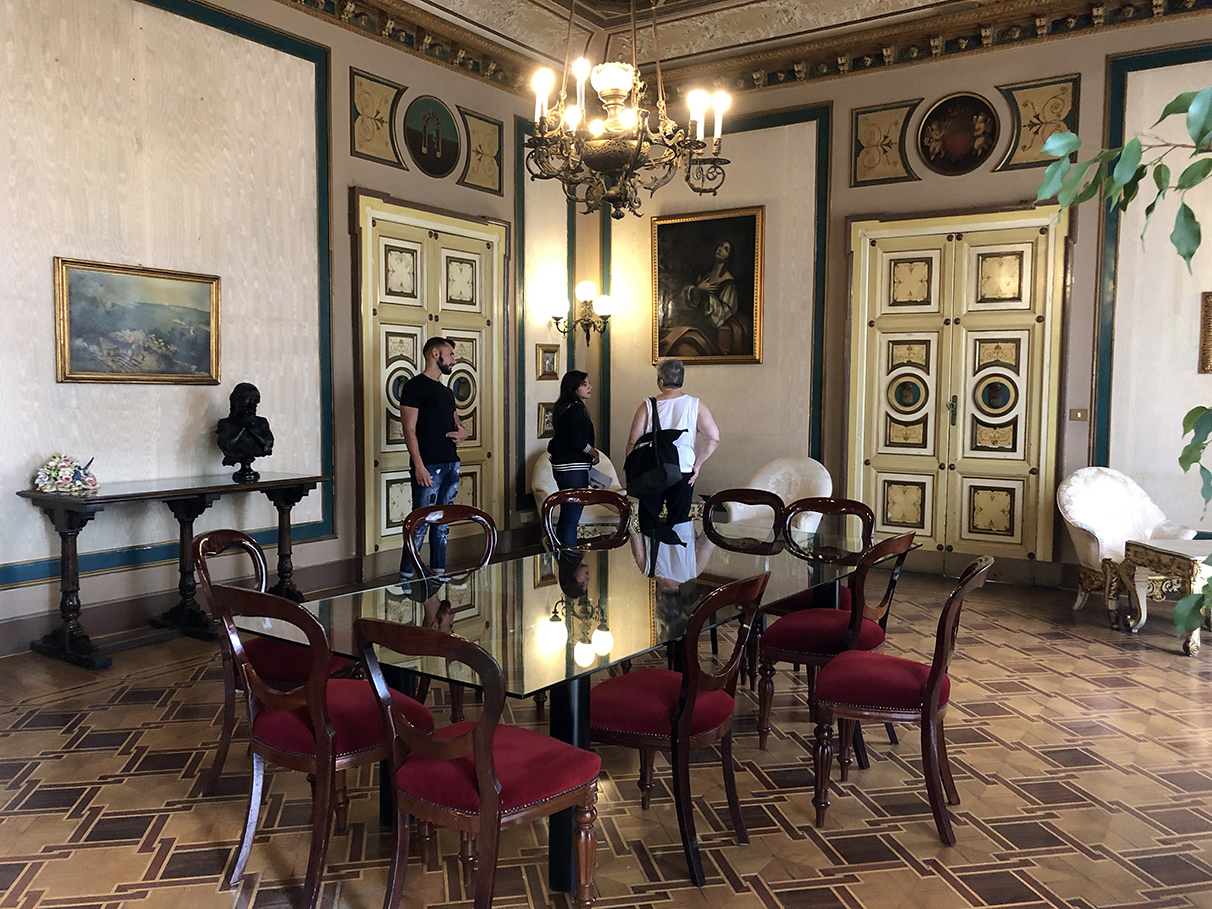
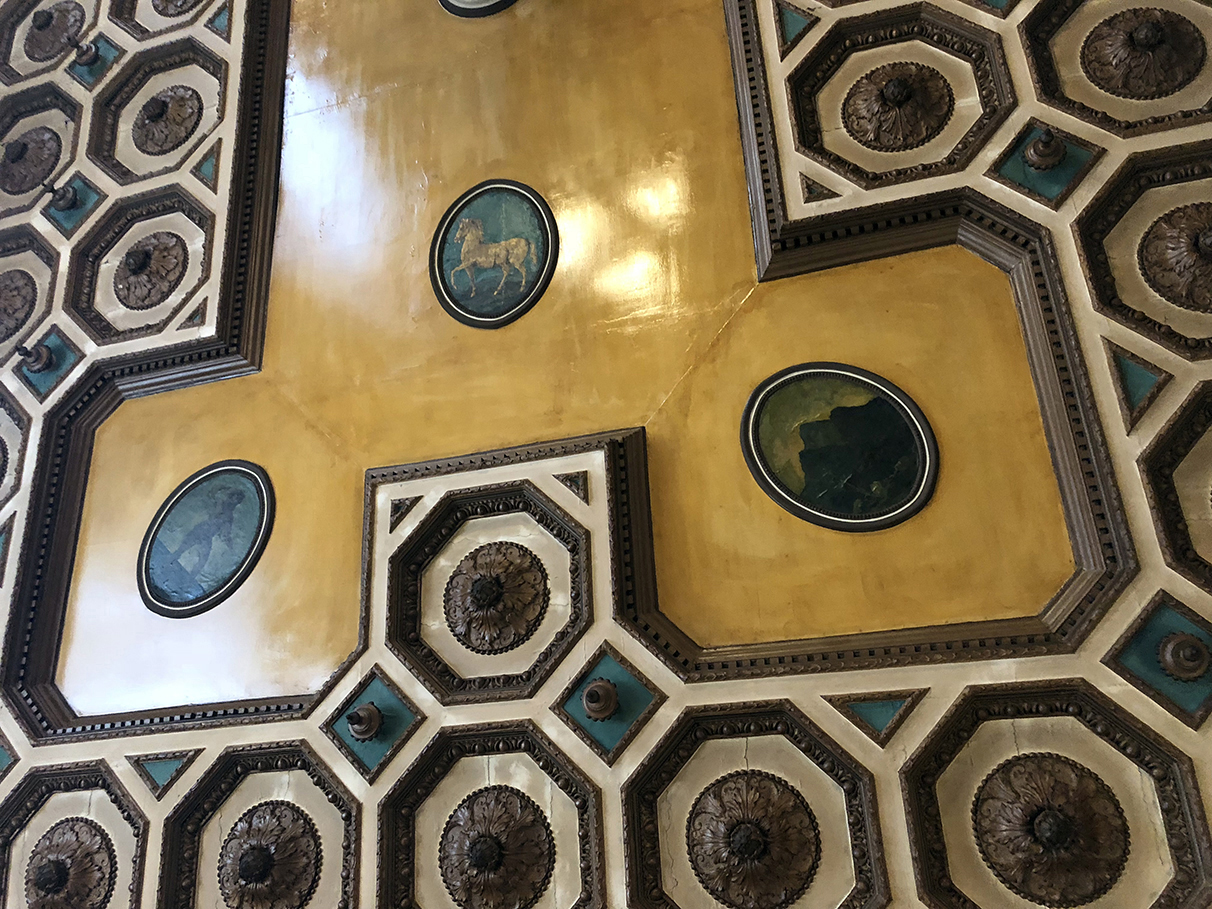
There’s even a Precepio. Apparently Christmas lasts year-round at City Hall.
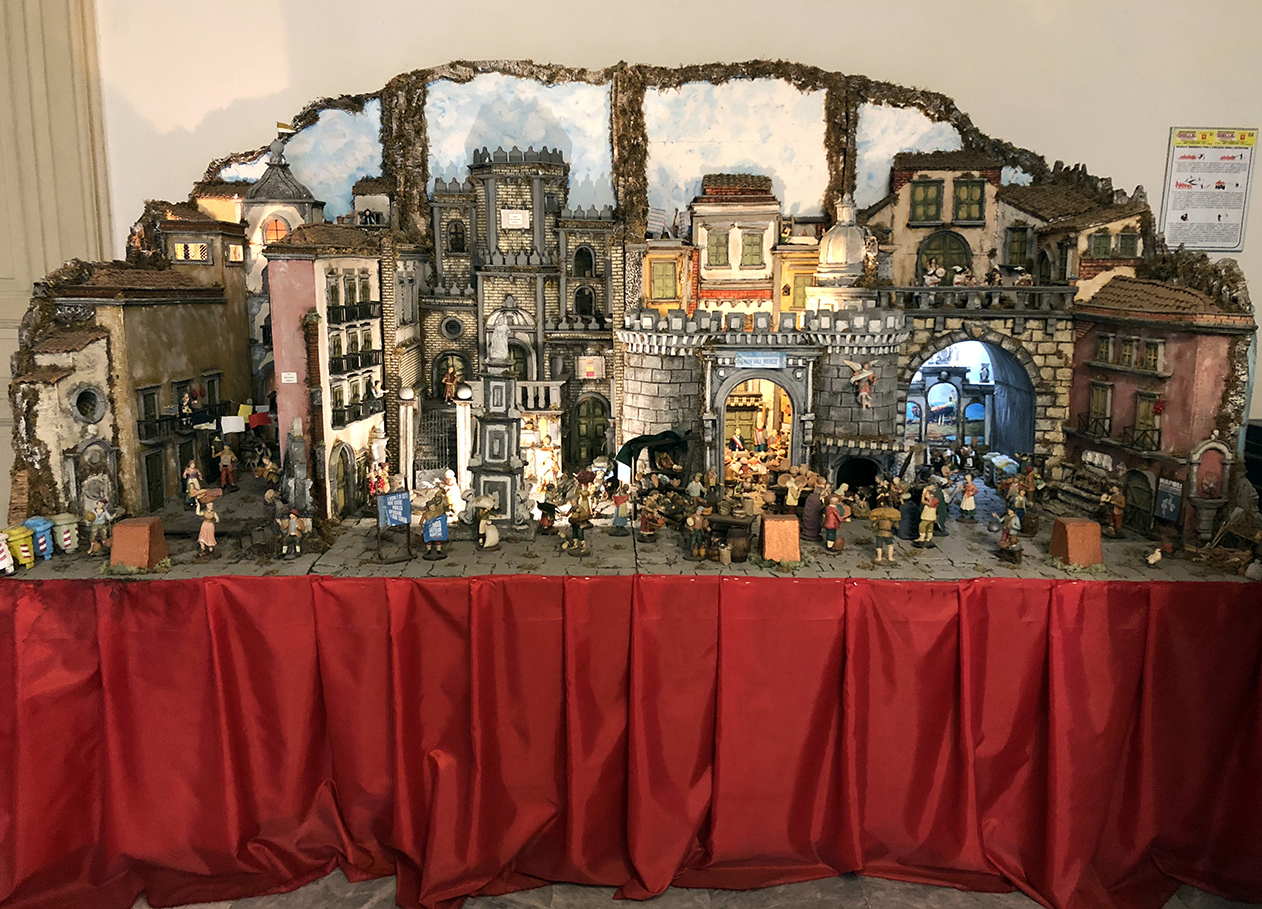
At one point, we stood outside a room full of people and looked at their heads from the hallway. Signor de Magistris is in there, but he’s doing a press conference, so you can’t meet him. Now we’re in an Altman movie: cue soundtrack of action in one room, talk from other room washing over us, people near the door turning around to “Shhhhh” us.
Would we like to see his office instead?
Sure.
We enter the corner room, filled with ornate furniture, and, on every surface, including every square inch of Signor de Magistris’s desk, are mementoes and tchotchkas with his name on them. Gifts from all quarters, apparently. Julie whispers to me, “He must have another office, too. Doesn’t look like much work gets done in this one.”



Look at that 19th-century painting. Could it be a Buongiorno, pleeeeease? (Not.)

Would we like a photograph of his desk. “Umm, okay.” We take one. No, would we like to SIT AT his desk. (So we can slip the plastic explosive under it more easily?) Surrrre. So I played potentate, and Julie stood behind me, and our guide shot a photo.

Who do they think we actually are, we wondered? (We didn’t notice anyone following us the rest of the day.)
Go to Naples, people! You can tour the mayor’s for-show office!
While I was chatting with the minders to distract them, Julie snagged a great shot of the newly re-opened Piazza Municipio from the mayor’s fourth floor window. Note the 1930s port building (behind the yellow crane) on the cruise ship docks beyond, and cloud-covered Mount Vesuvius 5 miles away.
De Magistris gets full, well-deserved, credit for the reconstruction of the piazza and for construction of the Metro station underneath it (note red M sign on pole and discreet entrance to station–stairs down surrounded by cement retaining wall–in front of the building on the right).

Here’s the obligatory selfie. A million thanks to my cousin Julie Holm who shot all these photos.

]]>
https://www.fathomevents.com/events/they-shall-not-grow-old
UPDATE December 17: No Americans in the film. The footage is all British, bummer, but the film is FABULOUS. I wrote about it here:
https://www.facebook.com/pg/51stPioneerInfantry/posts/?ref=page_internal
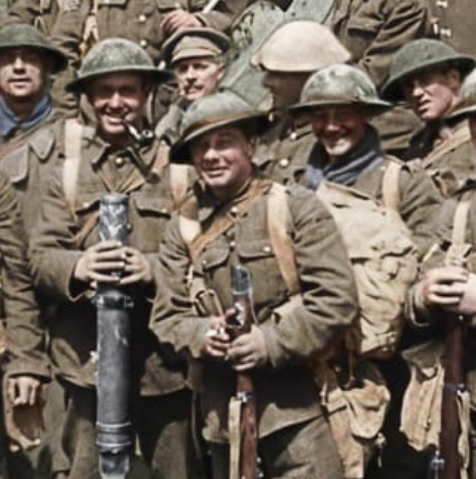
Day 9: Saturday, 27 Ottobre 2018.
Napoli, Campania: Apartment La Marinella.
Selfies with my Dutch friends who visited for a few days, Ruben and Ronny de Klerk, taken on the kitchen balcony (south-facing) of the apartment. Kudos to Ronny for suggesting the second photo with the neighbor’s laundry between us which illustrates his theory that there is a local law requiring displays of laundry on public-facing balconies to keep up the city’s “decoration” for tourists.
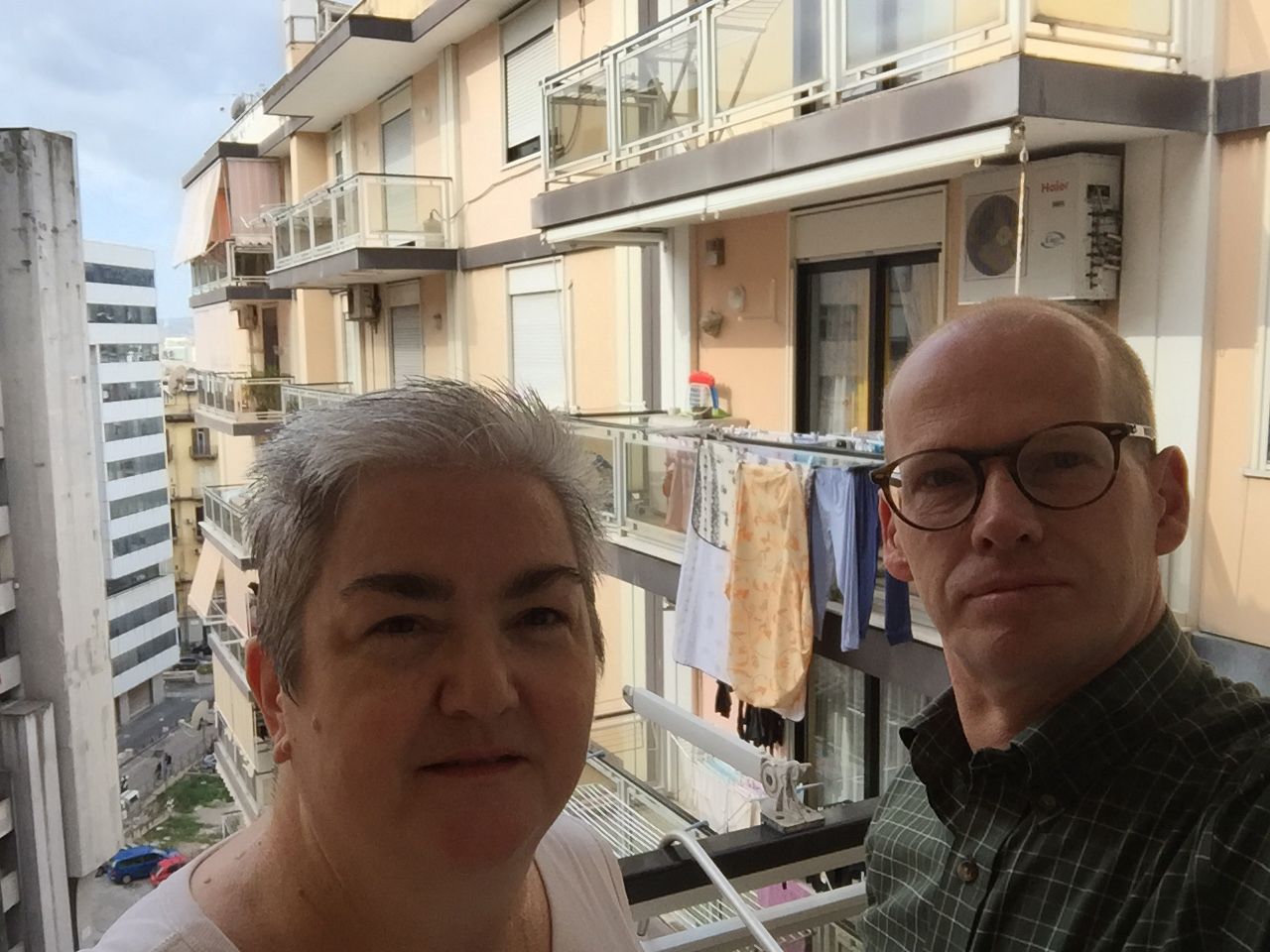
Day 9: Saturday, 27 Ottobre 2018.
Napoli, Campania: Isola di Capri.
I wanted to go to Capri for one reason. To take a photo of i Faraglioni from the same angle as this painting by Donatus Buongiorno which I own.

It’s an extremely well known site smack dab in the center of all things to do on Capri. How hard could it be?
Oy.
My cousin Julie went a few hours earlier than I did, as her interests are not as singularly obsessive as mine, and there were other sites on the island she wanted to see. We set a time to meet at i Faraglioni.
As the ferry boat pulled out of the Naples harbor, I sentimentally enjoyed this view, re-creating in my mind my grandfather Domenic Troisi’s last view of Naples when he left on a steamship in 1907 to migrate to the U.S. Sigh.
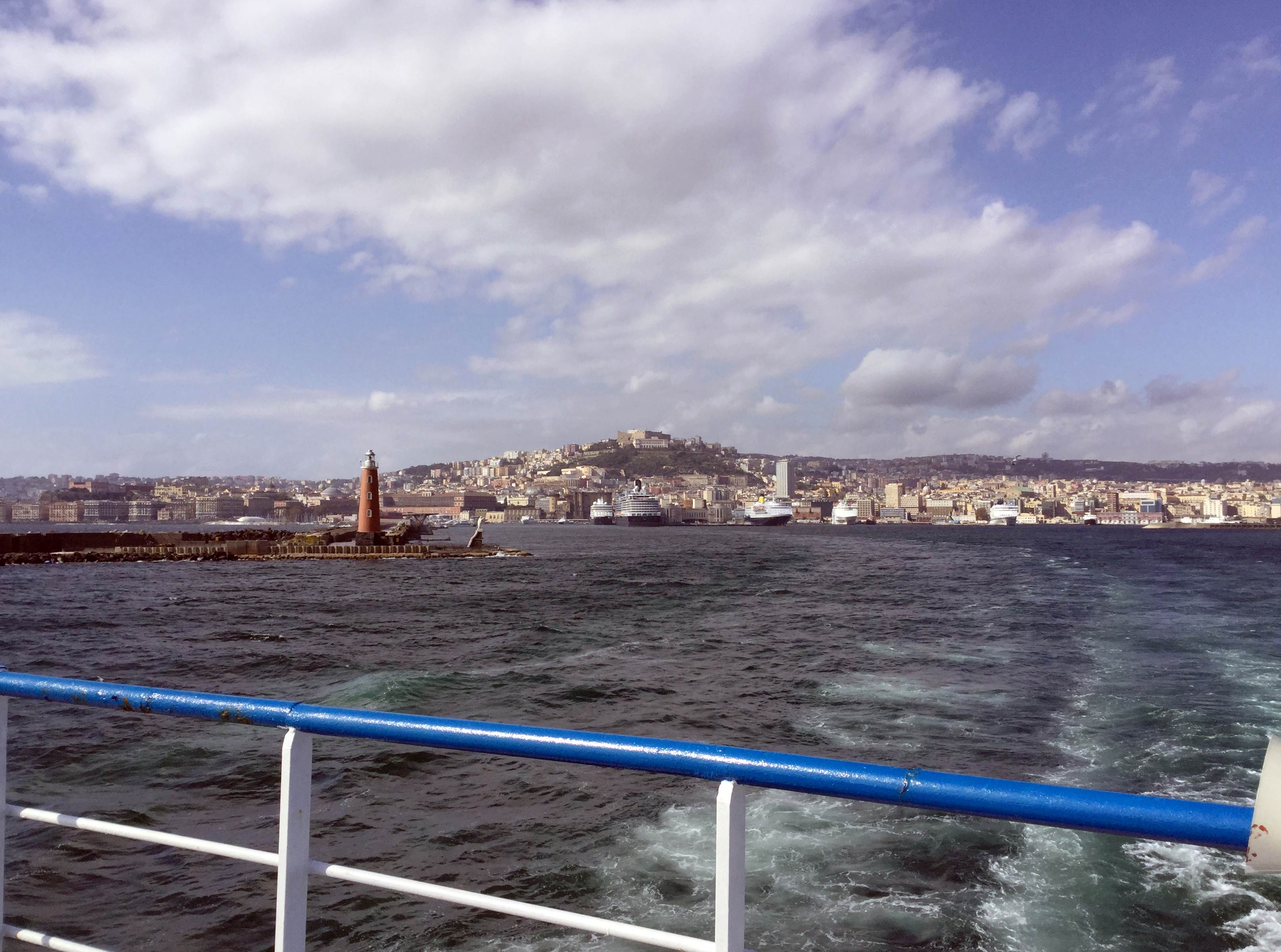
As always, Mount Vesuvius looms large over all things Neapolitano.
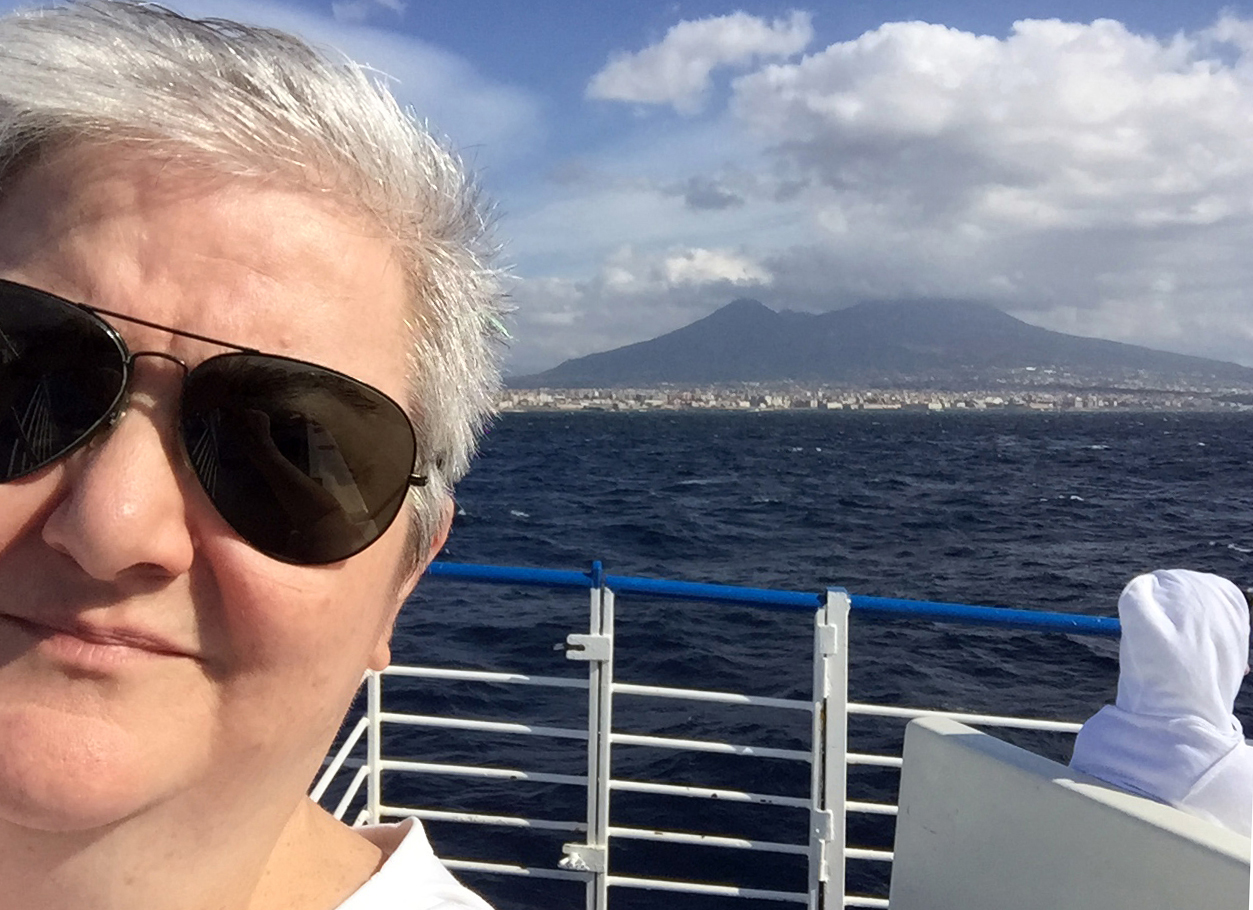
As the boat cleared the two breakwaters of the port, it started to heave substantially. I thought, “Hmm, choppier water than I would have expected. This a large boat to be thrown so much.”
1-1/2 seasick hours later, I debarked on Capri, paid a ripoff/captive-audience price of 10 euro for Dramamine (for the trip back), got advice from some Americans on where to find the funicular to the top of the hills, took it, walked through the “Rodeo Drive” of Capri (how the Americans described it)—luxury-store-only shopping streets at the top of the island which were really weird—to the gardens at the entrance to the Krupp Stairs one can use to walk down to sea level.
Turns out the stairs have been closed for 5 years. Why did no guide books say this? Umm, because my book is 10 years old, from when I first thought I was coming here. Oh.
Would I like to pay 1 euro to view the gardens only? (Yeah, alright, if it will get me into a toilet, too. It did.)
Julie and I were supposed to meet here, and we were both on time, but we figured out later, we must have been at different entrances, because we didn’t find each other.
So I viewed the gardens for 10 minutes and shot these photos. Do I sound bored? I’m a brat, right? Just look at these views!!! Then I hiked back up the hill to ride the funicular down the other side, figuring I would find Julie in the piazza where the ferry boats dock, knowing we would both end up there eventually.
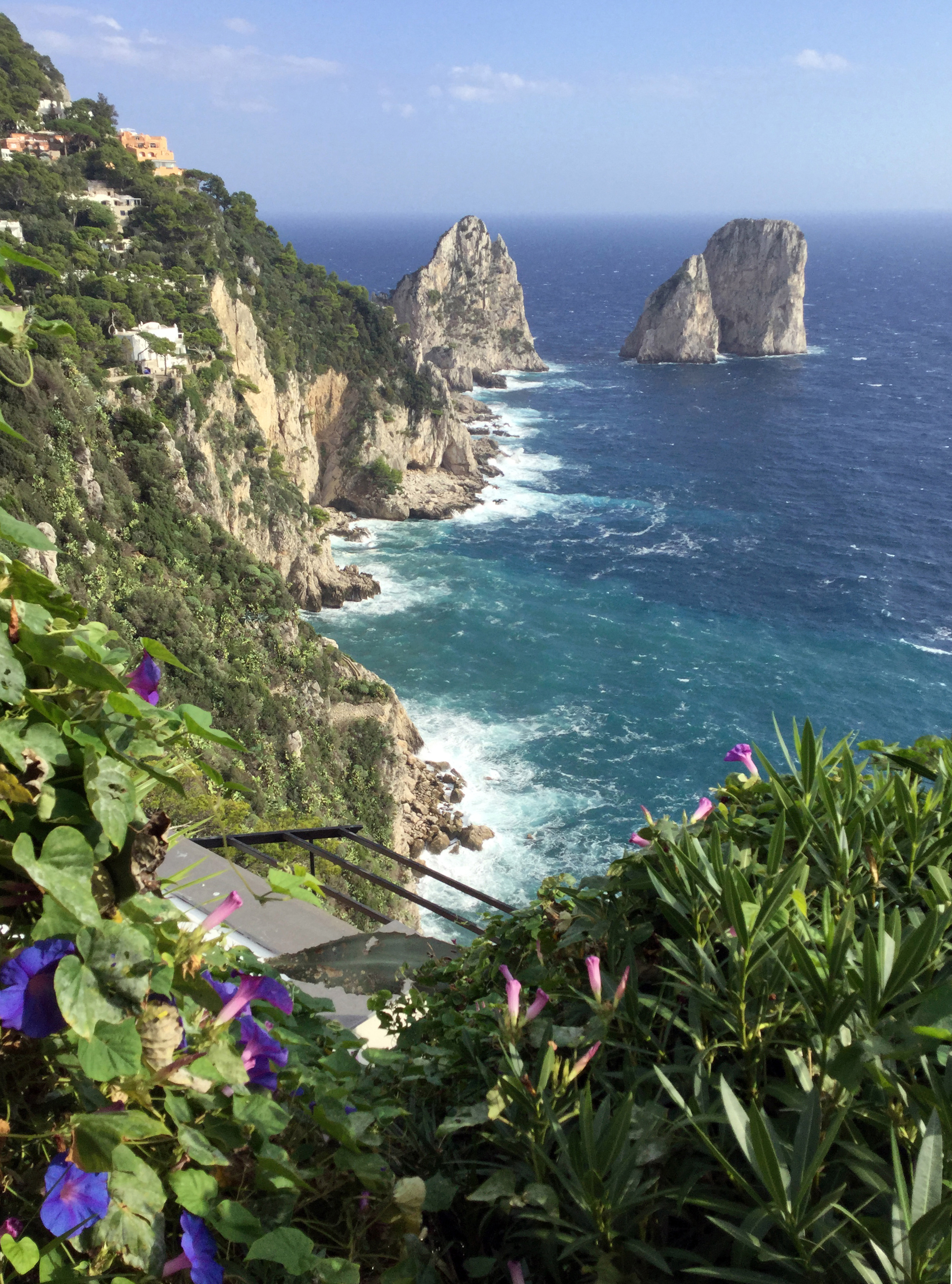
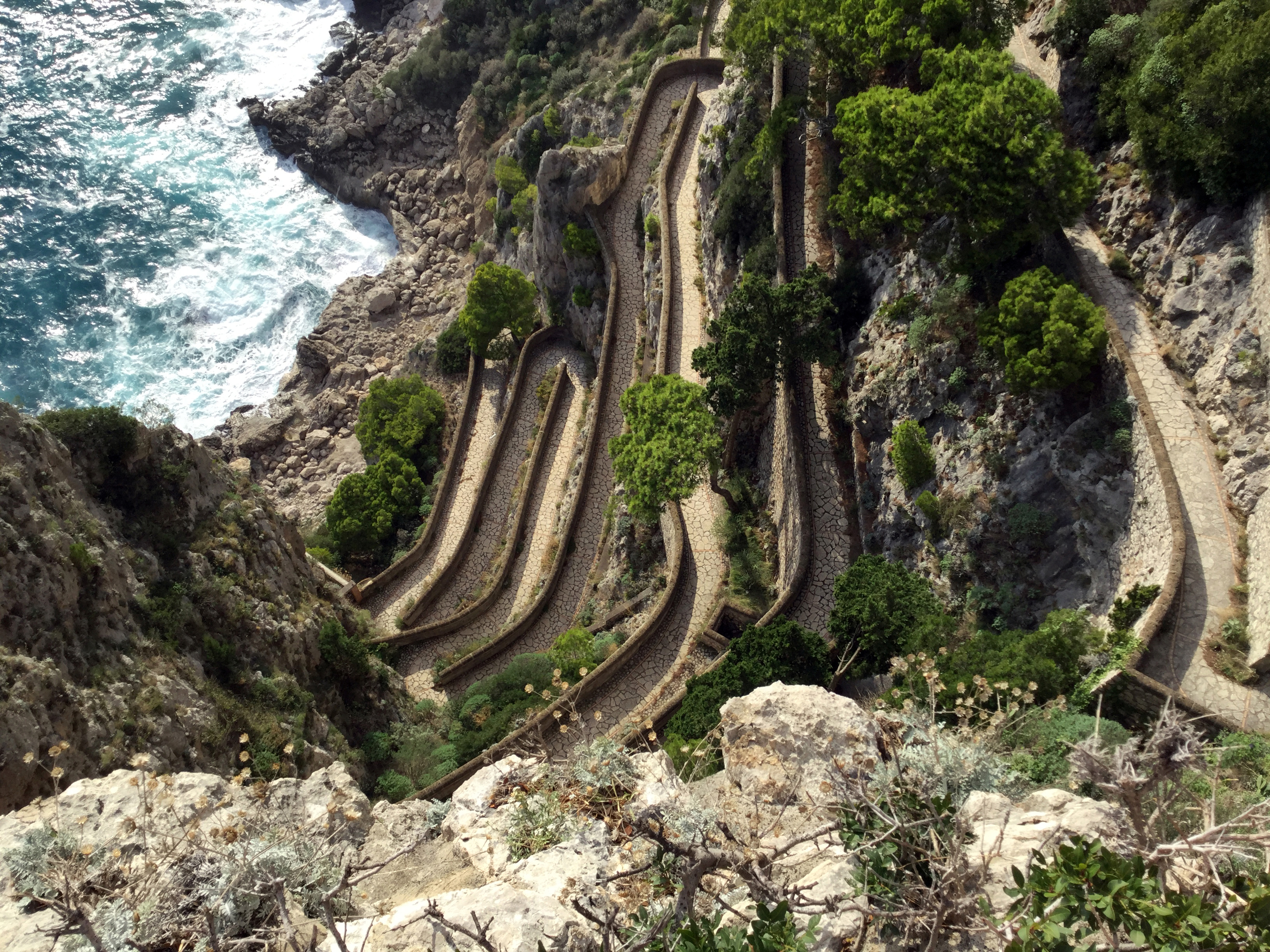
As I was poking around the ferry area, I figured, “Might as well buy my ticket.” I got to the window to see no available tickets to Naples until 12:30 a.m. Huh? Sold out on an off-season Saturday? But there was a boat to Sorrento where I knew I could get a train to Naples. It was in a few minutes, so I thought, “Sorry, Julie, I’m grabbing it.” (We’re both very experienced travelers and knew we didn’t need to worry about the other. Julie went through the same process about 1/2 hour behind me, and we met up at the apartment in Naples.)
I found out later that the ferries to Naples weren’t sold out, they were cancelled, due to high winds. It was a freak weather day, which explained that the choppy seas I experienced on the way to Capri weren’t typical.
The loud, boisterous, middle-aged French people on my ferry to Sorrento didn’t seem fazed. They were on a party tour, apparently. Here’s my proof:
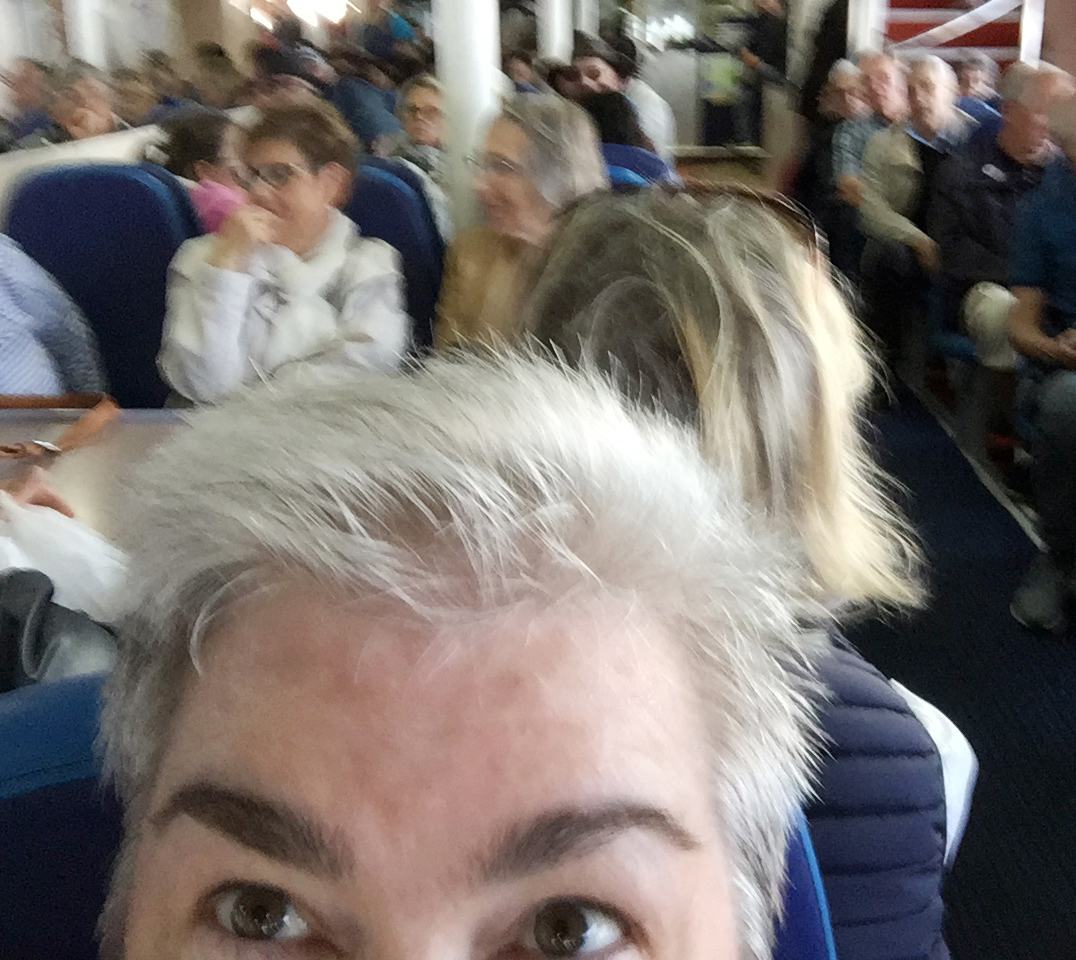
My cousin Julie, I concede, is a much more intrepid hiker than I am. Turns out she hiked down the cliffs by the pre-Krupp method—“stairs” and paths I can’t even imagine—and took photos for me at sea level, which she is generously sharing. Thank you, again, Julie, for covering one of my trip goals!
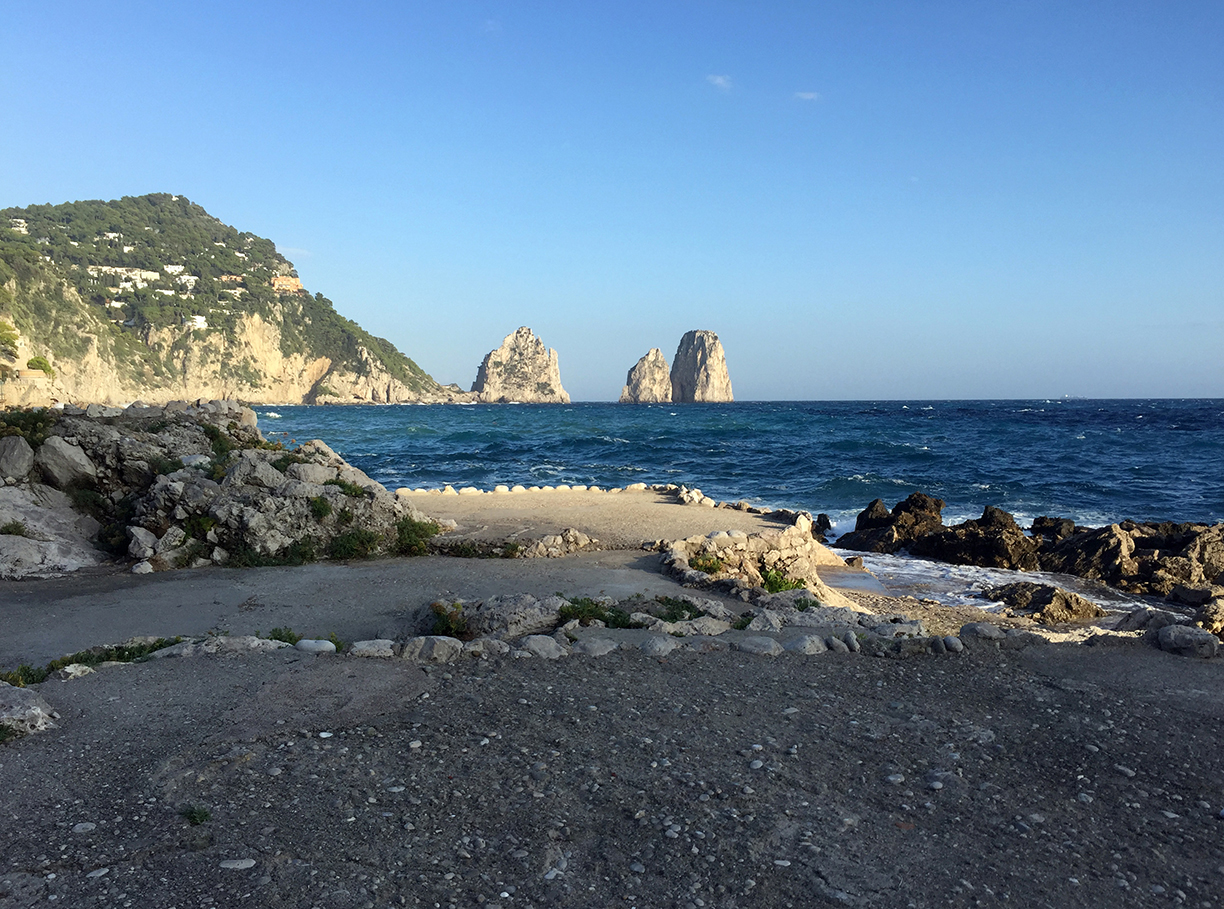
Here’s the painting again, for comparing.

Day 8: Friday, 26 Ottobre 2018.
Napoli, Campania: Vomero Hill.
Cousin Julie and I, who are doing advanced scouting for a condensed visit with family members who will arrive in a few days, decided that seeing this view from this Naples hill is a must-do/must-see, so we are re-arranging the group schedule to include it next Tuesday when museums will be closed. Julie shot the two panorama photos (with her extra phone, which she had lent to me, but then I gave it back—our identities were a little blurred at this point).
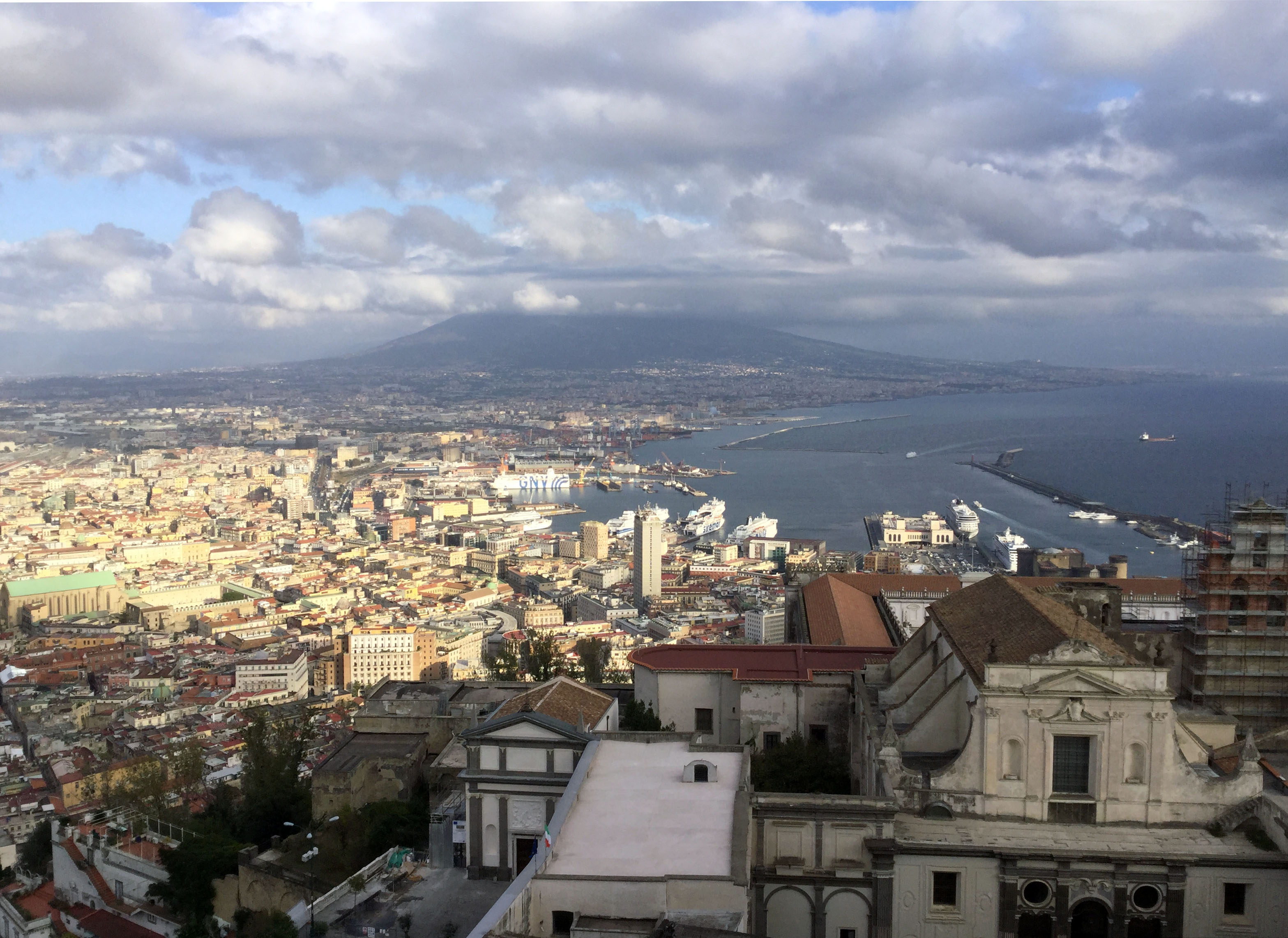


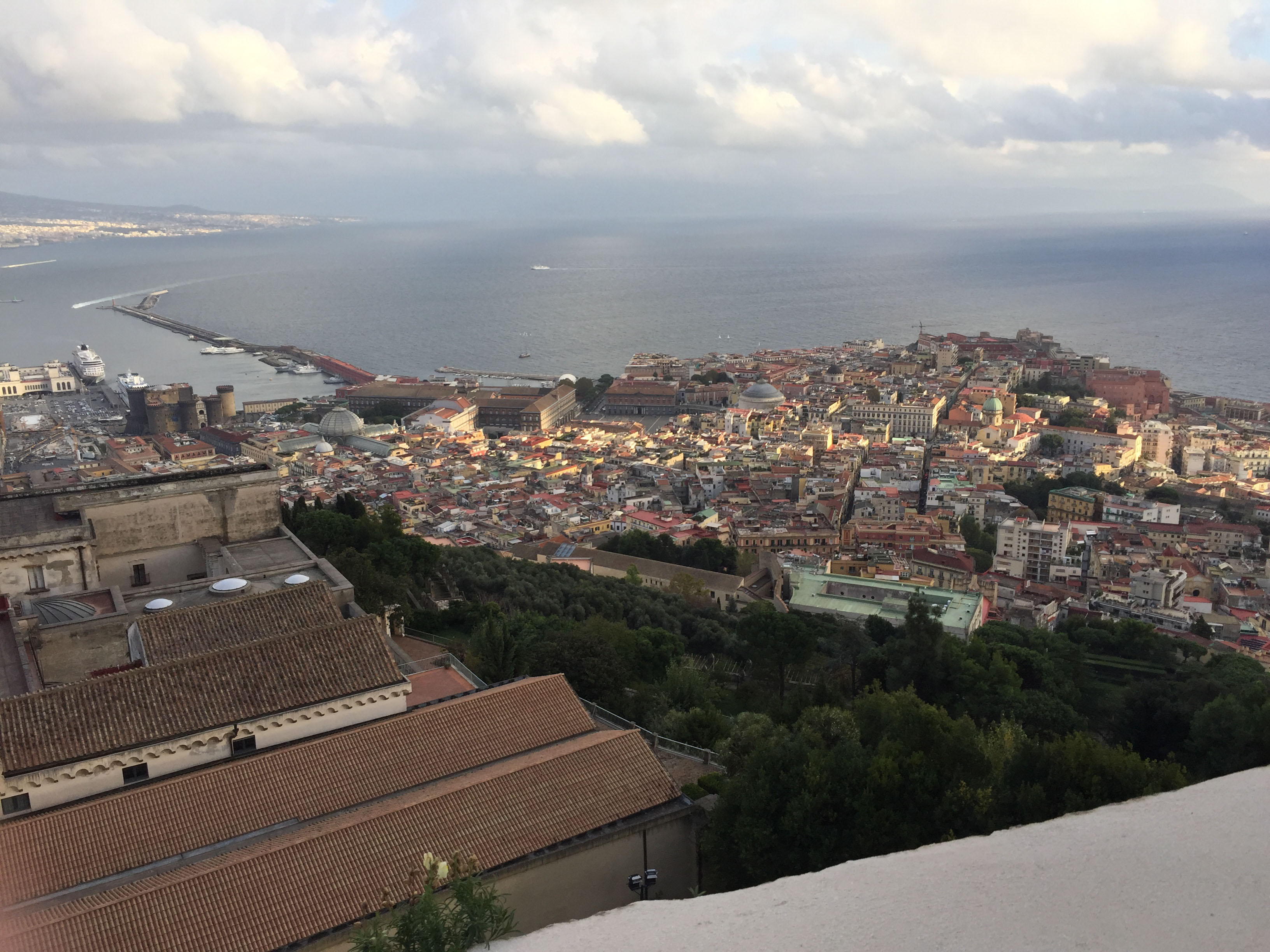
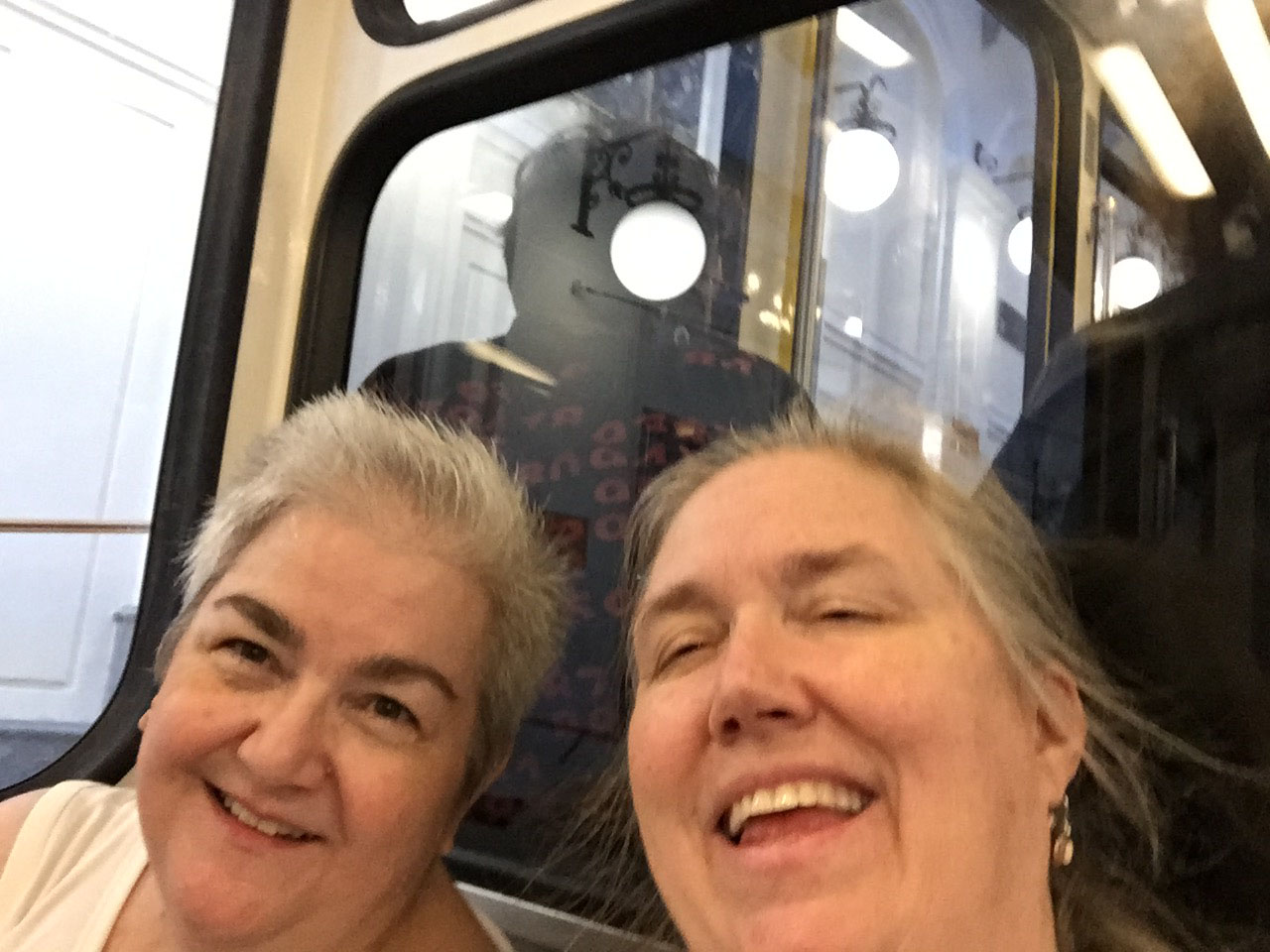
Day 8: Friday, 26 Ottobre 2018.
Napoli, Campania: Via Foria across from Museo subway station.
Intensive planning. Aided by very, very good coffee. This is my fabulous, fabulous first cousin, Julie Holm, who’s been a stalwart supporter of this trip (“I’m in!”) since Day 1 when I first proposed it ten years ago. Thank you, thank you, Julie for your help, patience, good ideas and good judgment, in the years before and days during this trip.
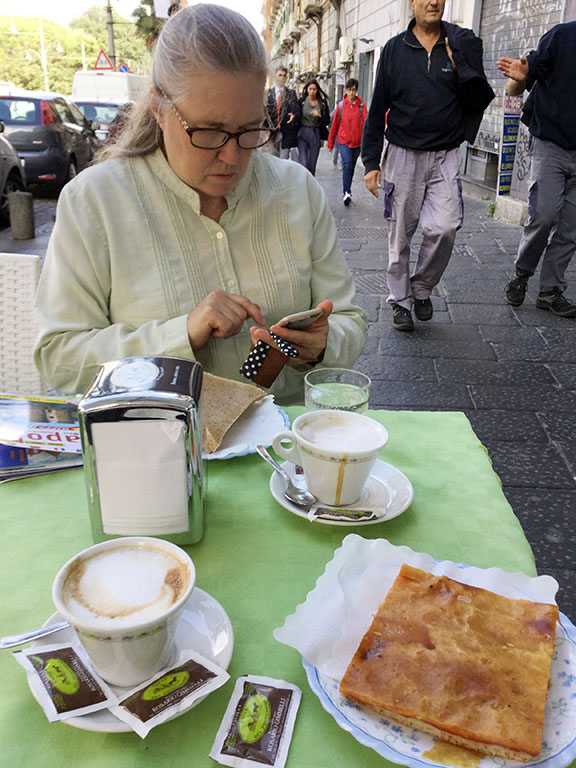
Day 7: Thursday, 25 Ottobre 2018.
Napoli, Campania: Via Cesare Rosaroll, 8:00 p.m.
Dinner?
